new posts in all blogs
Viewing: Blog Posts Tagged with: nonfiction picture books, Most Recent at Top [Help]
Results 1 - 25 of 69
How to use this Page
You are viewing the most recent posts tagged with the words: nonfiction picture books in the JacketFlap blog reader. What is a tag? Think of a tag as a keyword or category label. Tags can both help you find posts on JacketFlap.com as well as provide an easy way for you to "remember" and classify posts for later recall. Try adding a tag yourself by clicking "Add a tag" below a post's header. Scroll down through the list of Recent Posts in the left column and click on a post title that sounds interesting. You can view all posts from a specific blog by clicking the Blog name in the right column, or you can click a 'More Posts from this Blog' link in any individual post.
It’s finally come! The list is nearing its end. So it is with great delight that I present to you some of the last of the lists. Today’s is particularly long, celebrating what I consider to be some of the best books of 2016. Since so many of them have shown up on my other lists I’ll leave off the comments this time around except for those that haven’t appeared here before.
These are the nonfiction titles I was most impressed by in 2016:
2016 Nonfiction Picture Books
Ada Lovelace, Poet of Science: The First Computer Programmer by Diane Stanley, ill. Jessie Hartland

Ada’s Ideas: The Story of Ada Lovelace, the World’s First Computer Programmer by Fiona Robinson

Ada’s Violin: The Story of the Recycled Orchestra of Paraguay by Susan Hood, ill. Sally Wern Comport

Animals by the Numbers: A Book of Infographics by Steve Jenkins

Anything But Ordinary: The True Story of Adelaide Herman, Queen of Magic by Mara Rockliff, ill. Iacopo Bruno

A Beetle Is Shy by Dianna Hutts Aston, ill. Sylvia Long
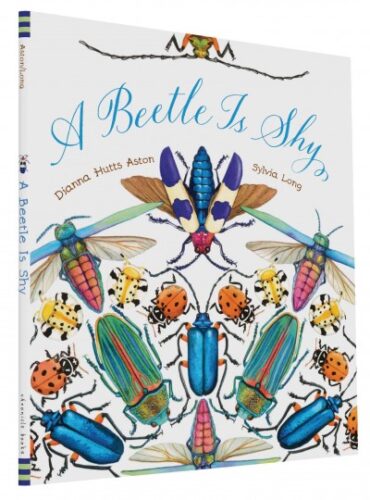
Circle by Jeanne Baker

Cloth Lullaby: The Woven Life of Louise Bourgeois by Amy Novesky, ill. Isabelle Arsenault

The Deadliest Creature in the World by Brena Z. Guiberson, ill. Gennady Spirin
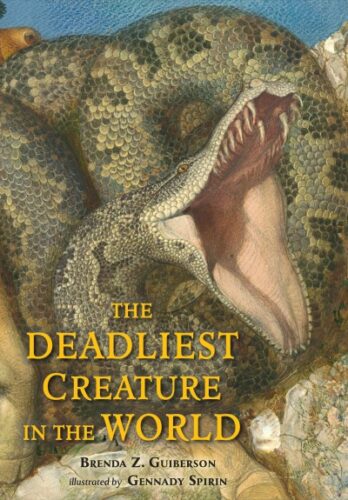
Death Is Stupid by Anastasia Higginbotham

Dining With Dinosaurs: A Tasty Guide to Mesozoic Munching by Hannah Bonner
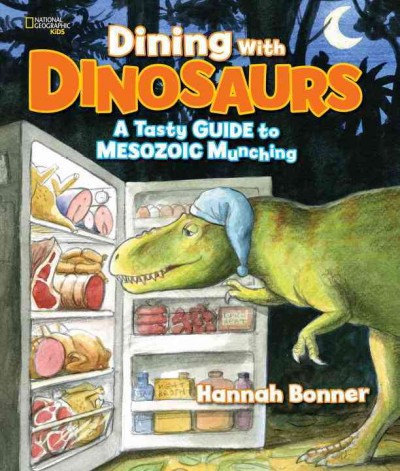
Does a Fiddler Crab Fiddle? by Corinne Demas & Artemis Roehrig, ill. John Sandford
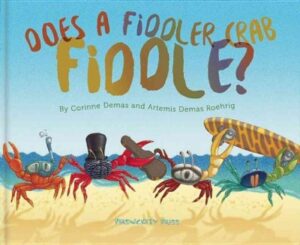
Dorothea’s Eyes by Barb Rosenstock, ill. Gerard DuBois
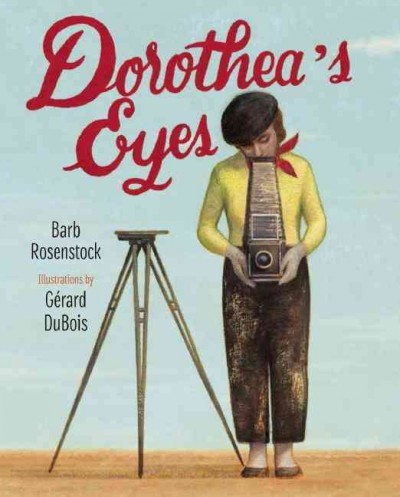
Elizabeth Started All the Trouble by Doreen Rappaport, ill. Matt Faulkner

Fancy Party Gowns: The Story of Ann Cole Lowe by Deborah Blumenthal, ill. Laura Freeman
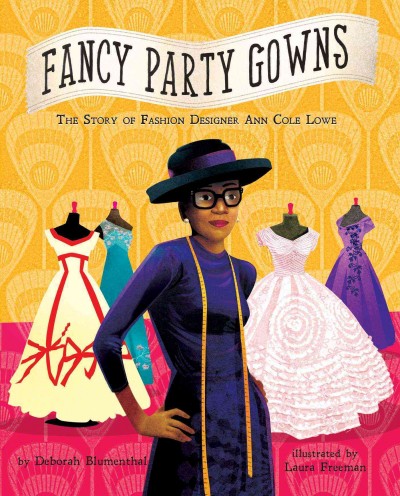
Gabe: A Story of Me, My Dog, and the 1970s by Shelley Gill, ill. Marc Scheff
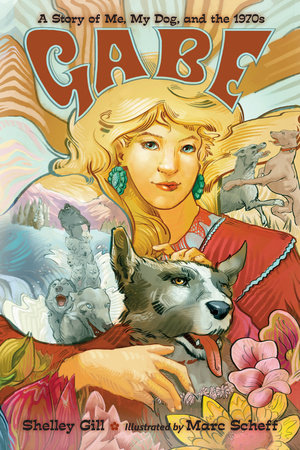
Grandmother Fish: A Child’s First Book of Evolution by Jonathan Tweet, ill. Karen Lewis

Growing Peace: A Story of Farming, Music, and Religious Harmony by Richard Sobol

If this hasn’t appeared on a list before it’s only because I’ve never found a place to slot it. Though it has elements of biography to it, it’s mostly about sustainable farming, overcoming religious differences, and working together. And since I never made a peace and global studies list (next year?) it shall go here instead.
How Cities Work by James Gulliver Hancock

Very keen. It’s a good book to use if you want to describe to a kid how cities form, what they contain, their problems, their solutions, and their future. Lots of lift-the-flap elements as well.
One note – if you’re buying this book for your system through Baker & Taylor, they’ll have a warning note attached saying that there are small parts and that it’s not appropriate for children under the age of three. They sometimes will put this warning on books with small lift-the-flap flaps. I personally think the book is safe, but you may be strict in your policies. FYI.
How Much Does a Ladybug Weigh? by Alison Limentani
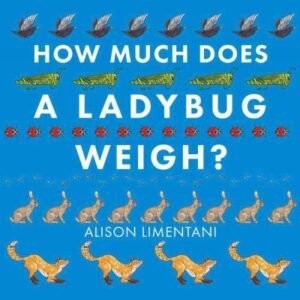
I Am NOT a Dinosaur! by Will Lach, ill. Jonny Lambert

I Dissent: Ruth Bader Ginsburg Makes Her Mark by Debbie Levy, ill. Elizabeth Baddeley
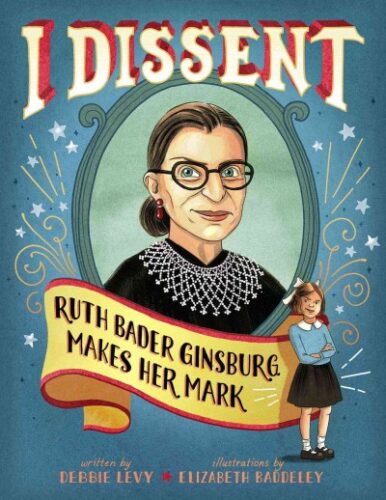
The Kid from Diamond Street: The Extraordinary Story of Baseball Legend Edith Houghton by Audrey Vernick, ill. Steven Salerno
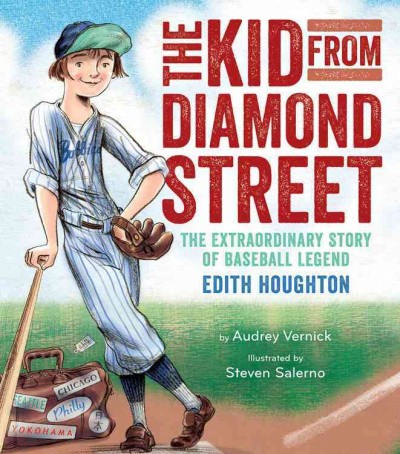
Lift Your Light a Little Higher: The Story of Stephen Bishop: Slave-Explorer by Heather Henson, ill. Bryan Collier
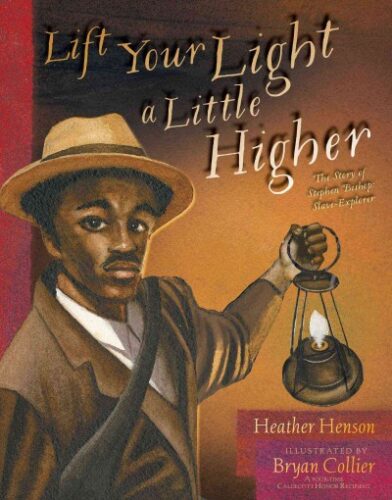
Martin Luther “Here I Stand” by Geraldine Elschner, translated by Kathryn Bishop
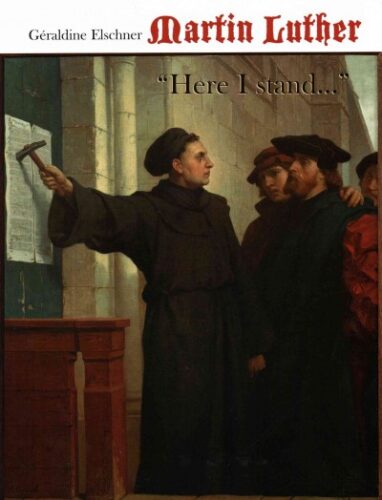
The Marvelous Thing That Came from a Spring: The Accidental Invention of the Toy That Swept the Nation by Gilbert Ford
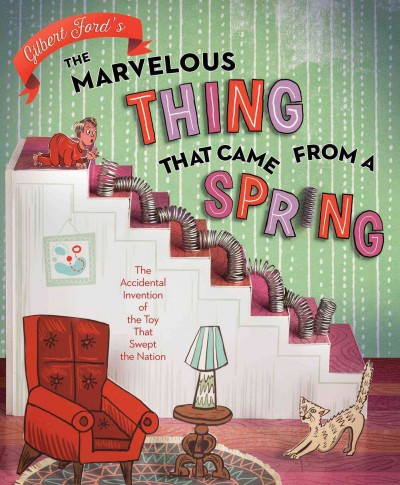
Since the book is focused far more on the invention than the inventor, I couldn’t really put it on the biographical list. So for all that it’s fun and funny and interesting and beautiful (really beautiful) I’ve had to wait until now to put it on any lists. That said, it was worth the wait.
Miracle Man: The Story of Jesus by John Hendrix
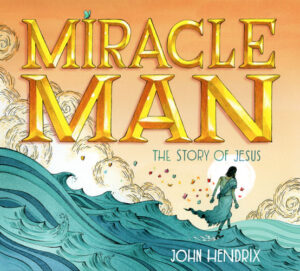
The Music in George’s Head: George Gershwin Creates Rhapsody in Blue by Suzanne Slade, ill. Stacy Innerst
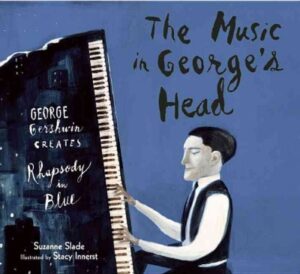
My Book of Birds by Geraldo Valerio
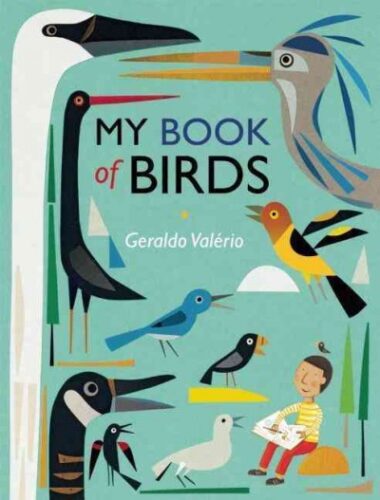
Natumi Takes the Lead: The True Story of an Orphan Elephant Who Finds Family by Gerry Ellis with Amy Novesky
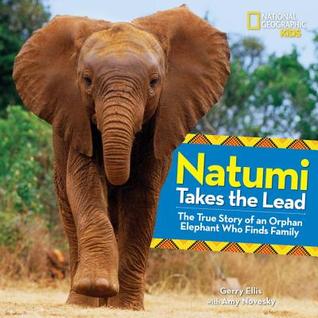
The Navajo Code Talkers by J. Patrick Lewis, ill. Gary Kelley

Olinguito, from A to Z! / Olinguito, de la A a la Z! by Lulu Delacre

Otters Love to Play by Jonathan London, ill. Meilo So

Pink Is for Blobfish: Discovering the World’s Perfectly Pink Animals by Jess Keating, ill. David DeGrand
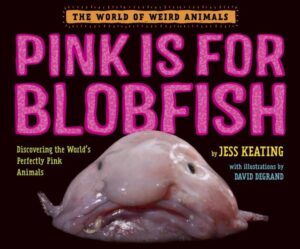
A Poem for Peter: The Story of Ezra Jack Keats and the Creation of The Snowy Day by Andrea Davis Pinkney, ill. Lou Fancher & Steve Johnson
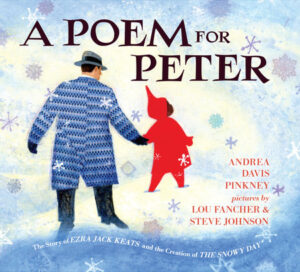
The Polar Bear by Jenni Desmond

Prairie Dog Song by Susan L. Roth and Cindy Trumbore

Radiant Child: The Story of Young Artist Jean-Michel Basquiat by Javaka Steptoe
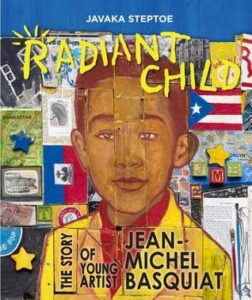
The Secret Subway by Shana Corey, ill. Red Nose Studio
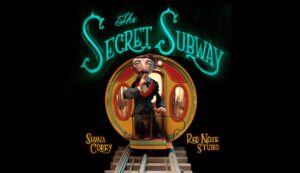
She Stood for Freedom: The Untold Story of a Civil Rights Hero, Joan Trumpauer Mulholland by Loki Mulholland & Angela Fairwell, ill. Charlotta Janssen
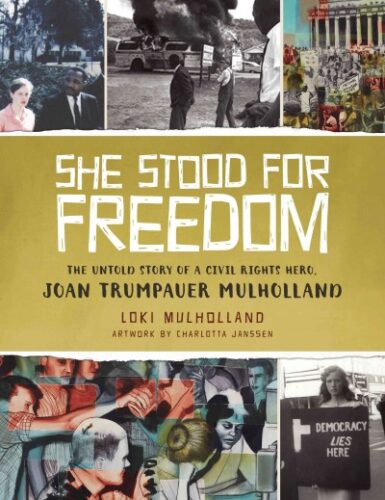
A Spy Called James: The True Story of James Lafayette, Revolutionary War Double Agent by Anne Rockwell, ill. Floyd Cooper
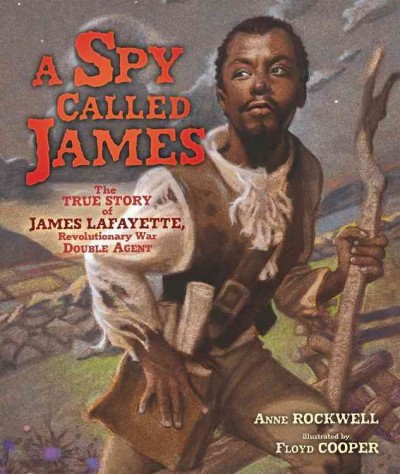
Step Right Up: How Doc and Jim Key Taught the World About Kindness by Donna Janell Bowman, ill. Daniel Minter
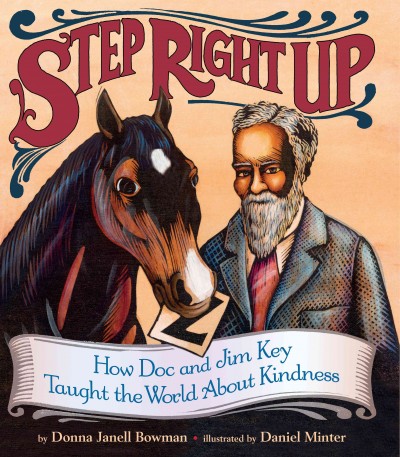
Ticktock Banneker’s Clock by Shana Keller, ill. David C. Gardner

The Toad by Elise Gravel
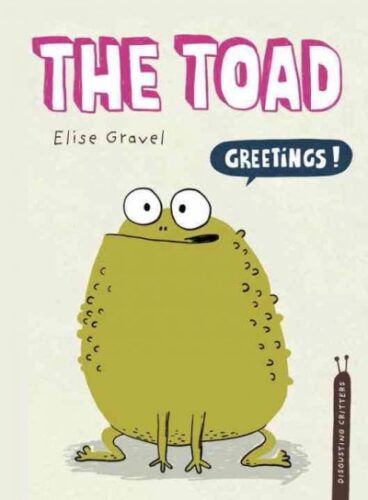
The Tudors: Kings, Queens, Scribes, and Ferrets! by Marcia Williams

Under Earth / Under Water by Aleksandra Mizielinska and Daniel Mizielinski

When Grandma Gatewood Took a Hike by Michelle Houts, ill. Erica Magnus

Whoosh! Lonnie Johnson’s Super-Soaking Stream of Inventions by Chris Barton, ill. Don Tate
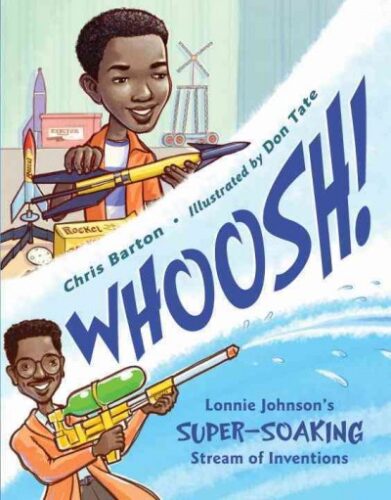
Whose Eye Am I? by Shelley Rotner
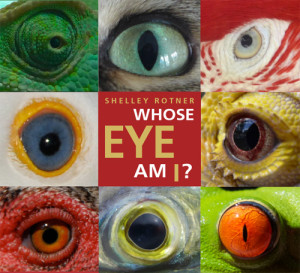
The William Hoy Story by Nancy Churnin, ill. Jez Tuya
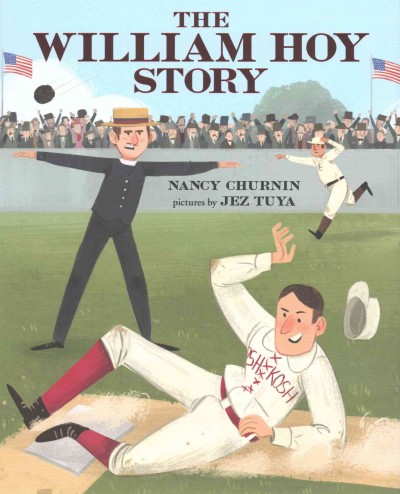
You Never Heard of Casey Stengel?! by Jonah Winter, ill. Barry Blitt
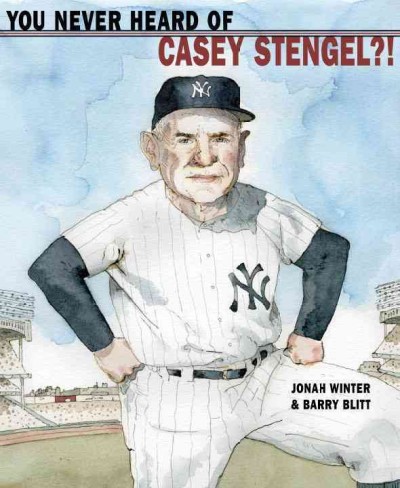
Interested in the other lists of the month? Here’s the schedule so that you can keep checking back:
December 1 – Board Books
December 2 – Board Book Adaptations
December 3 – Nursery Rhymes
December 4 – Picture Book Readalouds
December 5 – Rhyming Picture Books
December 6 – Alphabet Books
December 7 – Funny Picture Books
December 8 – Calde-Nots
December 9 – Picture Book Reprints
December 10 – Math Picture Books
December 11 – Bilingual Books
December 12 – International Imports
December 13 – Books with a Message
December 14 – Fabulous Photography
December 15 – Fairy Tales / Folktales
December 16 – Oddest Books of the Year
December 17 – Older Picture Books
December 18 – Easy Books
December 19 – Early Chapter Books
December 20 – Graphic Novels
December 21 – Poetry
December 22 – Fictionalized Nonfiction
December 23 – American History
December 24 – Science & Nature Books
December 25 – Transcendent Holiday Titles
December 26 – Unique Biographies
December 27 – Nonfiction Picture Books
December 28 – Nonfiction Chapter Books
December 29 – Novel Reprints
December 30 – Novels
December 31 – Picture Books


By:
Betsy Bird,
on 10/27/2016
Blog:
A Fuse #8 Production
(
Login to Add to MyJacketFlap)
JacketFlap tags:
Reviews,
nonfiction picture books,
Feiwel and Friends,
macmillan,
2016 reviews,
Reviews 2016,
2016 nonfiction picture books,
Jonathan Tweet,
Karen Lewis,
Add a tag
 Grandmother Fish: A Child’s First Book of Evolution
Grandmother Fish: A Child’s First Book of Evolution
By Jonathan Tweet
Illustrated by Karen Lewis
Feiwel and Friends (an imprint of Macmillan)
$17.99
ISBN: 978-1250113238
Ages 3-6
On shelves now
Travel back with me through the Earth’s history, back into the farthest reaches of time when the sand we walk today was still rock and the oceans of an entirely salination. Back back back we go to, oh about 13 years ago, I’d say. I was a library grad student, and had just come to the shocking realization that the children’s literature class I’d taken on a lark might actually yield a career of some sort. We were learning the finer points of book reviewing (hat tip to K.T. Horning’s From Cover to Cover there) and to hone our skills each of us was handed a brand new children’s book, ready for review. I was handed Our Family Tree: An Evolution Story by Lisa Westberg Peters, illustrated by Lauren Stringer. It was good, so I came up with some kind of a review. It was, now that I think about it, the very first children’s book review I ever wrote (talk about evolution). And I remember at the time thinking (A) How great it was to read a picture book on the topic and (B) That with my limited knowledge of the field there were probably loads and loads of books out there about evolution for small children. Fun Fact: There aren’t. Actually, in the thirteen years between then and now I’ve not seen a single evolution themed picture book come out since the Peters/Stringer collaboration. Until now. Because apparently two years before I ran across Our Family Tree author Jonathan Tweet was trying to figure out why there were so few books on the subject on the market. It took him a while, but he finally got his thoughts in order and wrote this book. Worth the wait and possibly the only book we may need on the subject. For a while, anyway.
Let’s start with a fish. We’ll call her Grandmother Fish and she lived “a long, long, long, long, long time ago.” She did familiar fishy things like “wiggle” and “chomp”. And then she had ancestors and they turned out to be everything from sharks to ray-finned fish to reptiles. That’s when you meet Grandmother Reptile, who lived “a long, long, long, long time ago.” From reptiles we get to mammals. From mammals to apes. And from apes to humans. And with each successive iteration, they carry with them the traits of their previous forms. Remember how Grandmother Fish could wiggle and chomp? Well, so can every subsequent ancestor, with some additional features as well. The final image in the book shows a wide range of humans and they can do the things mentioned in the book before. Backmatter includes a more complex evolutionary family tree, a note on how to use this book, a portion “Explaining Concepts of Evolution”, a guide “to the Grandmothers, Their Actions, and Their Grandchildren for your own information to help you explain evolution to your child”, and finally a portion on “Correcting Common Errors” (useful for both adults and kids).
 What are the forbidden topics of children’s literature? Which is to say, what are the topics that could be rendered appropriate for kids but for one reason or another never see the light of day? I can think of a couple off the top of my head, an evolution might be one of them. To say that it’s controversial in this, the 21st century, is a bit odd, but we live in odd times. No doubt the book’s creators have already received their own fair share of hate mail from folks who believe this content is inappropriate for their children. I wouldn’t be too surprised to hear that it ended up on ALA’s Most Challenged list of books in the future. Yet, as I mentioned before, finding ANY book on this subject, particularly on the young end of the scale, is near impossible. I am pleased that this book is filling such a huge gap in our library collections. Now if someone would just do something for the 7-12 year olds . . .
What are the forbidden topics of children’s literature? Which is to say, what are the topics that could be rendered appropriate for kids but for one reason or another never see the light of day? I can think of a couple off the top of my head, an evolution might be one of them. To say that it’s controversial in this, the 21st century, is a bit odd, but we live in odd times. No doubt the book’s creators have already received their own fair share of hate mail from folks who believe this content is inappropriate for their children. I wouldn’t be too surprised to hear that it ended up on ALA’s Most Challenged list of books in the future. Yet, as I mentioned before, finding ANY book on this subject, particularly on the young end of the scale, is near impossible. I am pleased that this book is filling such a huge gap in our library collections. Now if someone would just do something for the 7-12 year olds . . .
When you are simplifying a topic for children, one of the first things you need to figure out from the get-go is how young you want to go. Are you aiming your book at savvy 6-year-olds or bright-eyed and bushy-tailed 3-year-olds? In the case of Grandmother Fish the back-story to the book is that creator Jonathan Tweet was inspired to write it when he couldn’t find a book for his daughter on evolution. We will have to assume that his daughter was on the young end of things since the final product is very clearly geared towards the interactive picture book crowd. Readers are encouraged to wiggle, crawl, breathe, etc. and the words proved capable of interesting both my 2-year-old son and my 5-year-old daughter. One would not know from this book that the author hadn’t penned picture books for kids before. The gentle repetition and clincher of a conclusion suggest otherwise.
One problem with turning evolution into picture book fare is the danger of confusing the kids (of any age, really). If you play it that our ancestors were monkeys, then some folks might take you seriously. That’s where the branching of the tree becomes so interesting. Tweet and Lewis try hard to make it clear that though we might call a critter “grandmother” it’s not literally that kind of a thing. The problem is that because the text is so simple, it really does say that each creature had “many kinds of grandchildren.” Explaining to kids that this is a metaphor and not literal . . . well, good luck with that. You may find yourself leaning heavily on the “Correcting Common Errors” page at the end of the book, which aims to correct common misconceptions. There you will find gentle corrections to false statements like “We started as fish” or “Evolution progresses to the human form” or “We descended from one fish or pair of fish, or one early human or pair of early humans.” Of these Common Errors, my favorite was “Evolution only adds traits” since it was followed by the intriguing corrective, “Evolution also take traits away. Whales can’t crawl even though they’re descended from mammals that could.” Let’s talk about the bone structure of the dolphin’s flipper sometime, shall we? The accompanying “Explaining Concepts of Evolution” does a nice job of helping adults break down ideas like “Natural Selection” and “Artificial Selection” and “Descent with Modification” into concepts for young kids. Backmatter-wise, I’d give the book an A+. In terms of the story itself, however, I’m going with a B. After all, it’s not like every parent and educator that reads this book to kids is even going to get to the backmatter. I understand the decisions that led them to say that each “Grandmother” had “grandchildren” but surely there was another way of phrasing it.
 This isn’t the first crowd-sourced picture book I’ve ever seen, but it may be one of the most successful. The reason is partly because of the subject matter, partly because of the writing, and mostly because of the art. Bad art sinks even the most well-intentioned of picture books out there. Now I don’t know the back-story behind why Tweet paired with illustrator Karen Lewis on this book, but I hope he counts his lucky stars every day for her participation. First and foremost, he got an illustrator who had done books for children before (Arturo and the Navidad Birds probably being her best known). Second, her combination of watercolors and digital art really causes the pages to pop. The colors in particular are remarkably vibrant. It’s a pleasure to watch them, whether close up for one-on-one readings, or from a distance for groups. Whether on her own or with Tweet’s collaboration, her clear depictions of the evolutionary “tree” is nice and fun. Plus, it’s nice to see some early humans who aren’t your stereotypical white cavemen with clubs, for once.
This isn’t the first crowd-sourced picture book I’ve ever seen, but it may be one of the most successful. The reason is partly because of the subject matter, partly because of the writing, and mostly because of the art. Bad art sinks even the most well-intentioned of picture books out there. Now I don’t know the back-story behind why Tweet paired with illustrator Karen Lewis on this book, but I hope he counts his lucky stars every day for her participation. First and foremost, he got an illustrator who had done books for children before (Arturo and the Navidad Birds probably being her best known). Second, her combination of watercolors and digital art really causes the pages to pop. The colors in particular are remarkably vibrant. It’s a pleasure to watch them, whether close up for one-on-one readings, or from a distance for groups. Whether on her own or with Tweet’s collaboration, her clear depictions of the evolutionary “tree” is nice and fun. Plus, it’s nice to see some early humans who aren’t your stereotypical white cavemen with clubs, for once.
I look at this book and I wonder what its future holds. Will a fair number of public school libraries purchase it? They should. Will parents like Mr. Tweet be able to find it when they wander aimlessly into bookstores and libraries? One can hope. And is it any good? It is. But you only have my word on that one. Still, if great grand numbers of perfect strangers can band together to bring a book to life on a topic crying out for representation on our children’s shelves, you’ve gotta figure the author and illustrator are doing something right. A book that meets and then exceeds expectations, tackling a tricky subject, in a divisive era of our history, to the betterment of all. Not too shabby for a fish.
On shelves now.
Source: Final copy sent from publisher for review.
Like This? Then Try:


By:
Betsy Bird,
on 7/27/2016
Blog:
A Fuse #8 Production
(
Login to Add to MyJacketFlap)
JacketFlap tags:
Reviews,
nonfiction picture books,
Best Books,
picture book biographies,
Little Brown and Company,
African-American history,
Javaka Steptoe,
African-American biographies,
African-American picture book biographies,
African-American authors and illustrators,
2016 Caldecott contenders,
Best Books of 2016,
Reviews 2016,
2016 nonfiction picture books,
2016 picture book biographies,
Add a tag
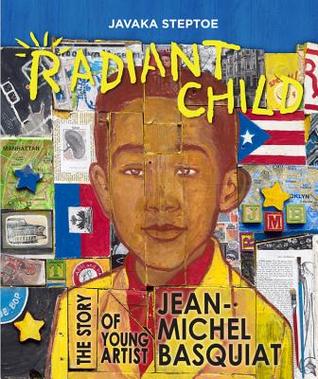 Radiant Child: The Story of Young Artist Jean-Michel Basquiat
Radiant Child: The Story of Young Artist Jean-Michel Basquiat
By Javaka Steptoe
Little, Brown & Co.
$17.99
ISBN: 978-0-316-21388-2
Ages 5 and up
On shelves October 25th
True Story: I’m working the children’s reference desk of the Children’s Room at 42nd Street of New York Public Library a couple years ago and a family walks in. They go off to read some books and eventually the younger son, I’d say around four years of age, approaches my desk. He walks right up to me, looks me dead in the eye, and says, “I want all your Javaka Steptoe books.” Essentially this child was a living embodiment of my greatest dream for mankind. I wish every single kid in America followed that little boy’s lead. Walk up to your nearest children’s librarian and insist on a full fledged heaping helping of Javaka. Why? Well aside from the fact that he’s essentially children’s book royalty (his father was the groundbreaking African-American picture book author/illustrator John Steptoe) he’s one of the most impressive / too-little-known artists working today. But that little boy knew him and if his latest picture book biography “Radiant Child: The Story of Young Artist Jean-Michel Basquiat” is even half as good as I think it is, a whole host of children will follow suit. But don’t take my word for it. Take that four-year-old boy’s. That kid knew something good when he saw it.
“Somewhere in Brooklyn, a little boy dreams of being a famous artist, not knowing that one day he will make himself a KING.” That boy is an artist already, though not famous yet. In his house he colors on anything and everything within reach. And the art he makes isn’t pretty. It’s, “sloppy, ugly, and sometimes weird, but somehow still BEAUTIFUL.” His mother encourages him, teaches him, and gives him an appreciation for all the art in the world. When he’s in a car accident, she’s the one who hands him Gray’s Anatomy to help him cope with what he doesn’t understand. Still, nothing can help him readily understand his own mother’s mental illness, particularly when she’s taken away to live where she can get help. All the same, that boy, Jean-Michel Basquiat, shows her his art, and with determination he grows up, moves to Manhattan, and starts his meteoric rise in the art scene. All this so that when, at long last, he’s at the top of his game, it’s his mother who sits on the throne at his art shows. Additional information about Basquiat appears at the back of the book alongside a key to the motifs in his work, an additional note from Steptoe himself on what Basquiat’s life and work can mean to young readers, and a Bibliography.
 Javaka Steptoe apparently doesn’t like to make things easy for himself. If he wanted to, he could illustrate all the usual African-American subjects we see in books every year. Your Martin Luther Kings and Rosa Parks and George Washington Carvers. So what projects does he choose instead? Complicated heroes who led complicated lives. Artists. Jimi Hendrix and guys like that. Because for all that kids should, no, MUST know who Basquiat was, he was an adult with problems. When Steptoe illustrated Gary Golio’s bio of Hendrix (Jimi: Sounds Like a Rainbow) critics were universal in their praise. And like that book, Steptoe ends his story at the height of Basquiat’s fame. I’ve seen some folks comment that the ending here is “abrupt” and that’s not wrong. But it’s also a natural high, and a real time in the man’s life when he was really and truly happy. When presenting a subject like Basquiat to a young audience you zero in on the good, acknowledge the bad in some way (even if it’s afterwards in an Author’s Note), and do what you can to establish precisely why this person should be mentioned alongside those Martin Luther Kings, Rosa Parks, and George Washington Carvers.
Javaka Steptoe apparently doesn’t like to make things easy for himself. If he wanted to, he could illustrate all the usual African-American subjects we see in books every year. Your Martin Luther Kings and Rosa Parks and George Washington Carvers. So what projects does he choose instead? Complicated heroes who led complicated lives. Artists. Jimi Hendrix and guys like that. Because for all that kids should, no, MUST know who Basquiat was, he was an adult with problems. When Steptoe illustrated Gary Golio’s bio of Hendrix (Jimi: Sounds Like a Rainbow) critics were universal in their praise. And like that book, Steptoe ends his story at the height of Basquiat’s fame. I’ve seen some folks comment that the ending here is “abrupt” and that’s not wrong. But it’s also a natural high, and a real time in the man’s life when he was really and truly happy. When presenting a subject like Basquiat to a young audience you zero in on the good, acknowledge the bad in some way (even if it’s afterwards in an Author’s Note), and do what you can to establish precisely why this person should be mentioned alongside those Martin Luther Kings, Rosa Parks, and George Washington Carvers.
There’s this moment in the film Basquiat when David Bowie (playing Andy Warhol) looks at some of his own art and says off-handedly, “I just don’t know what’s good anymore.” I have days, looking at the art of picture books when I feel the same way. Happily, there wasn’t a minute, not a second, when I felt that way about Radiant Child. Now I’m going to let you in on a little secret: Do you know what one of the most difficult occupations to illustrate a picture book biography about is? Artist. Because right from the start the illustrator of the book is in a pickle. Are you going to try to replicate the art of this long dead artist? Are you going to grossly insert it into your own images, even if the book isn’t mixed media to begin with? Are you going to try to illustrate the story in that artist’s style alone, relegating images of their actual art to the backmatter? Steptoe addresses all this in his Note at the back of the book. As he says, “Instead of reproducing or including copies of real Basquiat paintings in this book, I chose to create my own interpretations of certain pieces and motifs.” To do this he raided Basquiat’s old haunts around NYC for discarded pieces of wood to paint on. The last time I saw this degree of attention paid to painting on wood in a children’s book was Paul O. Zelinsky’s work on Swamp Angel. In Steptoe’s case, his illustration choice works shockingly well. Look how he manages to give the reader a sense of perspective when he presents Picasso’s “Guernica” at an angle, rather than straight on. Look how the different pieces of wood, brought together, fit, sometimes including characters on the same piece to show their closeness, and sometimes painting them on separate pieces as a family is broken apart. And the remarkable thing is that for all that it’s technically “mixed-media”, after the initial jolt of the art found on the title page (a full wordless image of Basquiat as an adult surrounded by some of his own imagery) you’re all in. You might not even notice that even the borders surrounding these pictures are found wood as well.
 The precise age when a child starts to feel that their art is “not good” anymore because it doesn’t look realistic or professional enough is relative. Generally it happens around nine or ten. A book like Radiant Child, however, is aimed at younger kids in the 6-9 year old range. This is good news. For one thing, looking at young Basquiat vs. older Basquiat, it’s possible to see how his art is both childlike and sophisticated all at once. A kid could look at what he’s doing in this book and think, “I could do that!” And in his text, Steptoe drills into the reader the fact that even a kid can be a serious artist. As he says, “In his house you can tell a serious ARTIST dwells.” No bones about it.
The precise age when a child starts to feel that their art is “not good” anymore because it doesn’t look realistic or professional enough is relative. Generally it happens around nine or ten. A book like Radiant Child, however, is aimed at younger kids in the 6-9 year old range. This is good news. For one thing, looking at young Basquiat vs. older Basquiat, it’s possible to see how his art is both childlike and sophisticated all at once. A kid could look at what he’s doing in this book and think, “I could do that!” And in his text, Steptoe drills into the reader the fact that even a kid can be a serious artist. As he says, “In his house you can tell a serious ARTIST dwells.” No bones about it.
How much can a single picture book bio do? Pick a good one apart and you’ll see all the different levels at work. Steptoe isn’t just interested in celebrating Basquiat the artist or encouraging kids to keep working on their art. He also notes at the back of the book that the story of Basquiat’s relationship with his mother, who suffered from mental illness, was very personal to him. And so, Basquiat’s mother remains an influence and an important part of his life throughout the text. You might worry, and with good reason, that the topic of mental illness is too large for a biography about someone else, particularly when that problem is not the focus of the book. How do you properly address such an adult problem (one that kids everywhere have to deal with all the time) while taking care to not draw too much attention away from the book’s real subject? Can that even be done? Sacrifices, one way or another, have to be made. In Radiant Child Steptoe’s solution is to show Jean-Michel within the lens of his art’s relationship to his mother. She talks to him about art, takes him to museums, and encourages him to keep creating. When he sees “Guernica”, it’s while he’s holding her hand. And because Steptoe has taken care to link art + mom, her absence is keenly felt when she’s gone. The book’s borders go a dull brown. Just that single line “His mother’s mind is not well” says it succinctly. Jean-Michel is confused. The kids reading the book might be confused. But the feeling of having a parent you are close to leave you . . . we can all relate to that, regardless of the reason. It’s just going to have a little more poignancy for those kids that have a familiarity with family members that suffer mental illnesses. Says Steptoe, maybe with this book those kids can, “use Basquiat’s story as a catalyst for conversation and healing.”
That’s a lot for a single picture book biography to take on. Yet I truly believe that Radiant Child is up to the task. It’s telling that in the years since I became a children’s librarian I’ve seen a number of Andy Warhol biographies and picture books for kids but the closest thing I ever saw to a Basquiat bio for children was Life Doesn’t Frighten Me as penned by Maya Angelou, illustrated by Jean-Michel. And that wasn’t even really a biography! For a household name, that’s a pretty shabby showing. But maybe it makes sense that only Steptoe could have brought him to proper life and to the attention of a young readership. In such a case as this, it takes an artist to display another artist. Had Basquiat chosen to create his own picture book autobiography, I don’t think he could have done a better job that what Radiant Child has accomplished here. Timely. Telling. Overdue.
On shelves October 25th.
Source: F&G sent from publisher for review.
Professional Reviews: A star from Kirkus


By:
Betsy Bird,
on 2/25/2016
Blog:
A Fuse #8 Production
(
Login to Add to MyJacketFlap)
JacketFlap tags:
Reviews,
Lee & Low Books,
nonfiction picture books,
Best Books,
alphabet books,
Lulu Delacre,
Best Books of 2016,
2016 reviews,
Reviews 2016,
2016 nonfiction picture books,
Add a tag
 ¡Olinguito, de la A a la Z! / Olinguito, from A to Z
¡Olinguito, de la A a la Z! / Olinguito, from A to Z
By Lulu Delacre
Children’s Book Press, an imprint of Lee & Low Books
$18.95
ISBN: 978-0-89239-327-5
Ages 4-7
On shelves now
Adults, I have a little secret. Have you ever wanted to sound smart at dinner parties? Knowledgeable in the ways of the world and how it works? It’s easy to do if you know the secret. Come closer… I’ll whisper it to you. Read nonfiction children’s books. Seriously, do that and watch as your brain expands. If I can talk with any competency about the Donner Party or the siege of Leningrad or the Pentagon Papers, it is because I read nonfiction written for people half my age and younger. Most recently I learned about olinguitos. Ever heard of them? If not, you aren’t alone. These shy little rainforest denizens were only discovered and announced as recently as 2013. Not too much is known about them, which makes placing them into picture books a bit of a challenge. Author/illustrator Lulu Delacre had a plan, though. All she’d need to do would be to turn the story of the discovery of olinguitos into a bilingual/alphabet/nonfiction/search & find title. You see? Easy peasy. Or, put another way, so incredibly difficult that no one else would have ever attempted it. But that’s what I like about Ms. Delacre. Sometimes the craziest ideas churn out the most interesting books.
 A zoologist from Washington D.C. is in the cloud forest today. He is searching for the elusive olinguito, a squirrel-like mammal that dwells in the trees. Along his path we meet the rainforest in an abecedarian fashion. From the A for the Andes to the M of moss and monkey, finally ending with Z for the zoologist himself, the book observes the many denizens that call the cloud forest their home. The book is entirely bilingual and backmatter (also bilingual) consists of notes on the “Discovery of the Olinguito”, facts about the Cloud Forest, information about the illustrations, hints on how to be an explorer, a heavily illustrated Glossary, “More Helpful Words”, and an extensive list of Author’s Sources.
A zoologist from Washington D.C. is in the cloud forest today. He is searching for the elusive olinguito, a squirrel-like mammal that dwells in the trees. Along his path we meet the rainforest in an abecedarian fashion. From the A for the Andes to the M of moss and monkey, finally ending with Z for the zoologist himself, the book observes the many denizens that call the cloud forest their home. The book is entirely bilingual and backmatter (also bilingual) consists of notes on the “Discovery of the Olinguito”, facts about the Cloud Forest, information about the illustrations, hints on how to be an explorer, a heavily illustrated Glossary, “More Helpful Words”, and an extensive list of Author’s Sources.
I’ve read plenty of Spanish bilingual picture books in my day. In doing so, I’m a bit handicapped since I don’t speak the language. Still, there are things that I can observe from my end. For example, the difficulty Ms. Delacre must have faced in writing two texts, both of which had to contain specific letters of the alphabet. Now the primary language in this book, to a certain extent, is the Spanish. For each letter the Spanish sections get a lot more use than the English. Take the letter “J”. In the Spanish language section it reads, “Jigua jaguey y jazmin brotan, crecen en tal jardin.” Pretty straightforward. Now in the English: “Jigua, fig, and coffee trees sprout and grow in this garden.” Were it not for the “jingua” we’d be out a J. To be fair, sometimes the two languages get equal use of a letter. “I”, for example, is “insectos incredibles y una inerte iguana” and also “incredible insects, and a resting iguana.” However, more often than not the Spanish gets more words with the chosen letter. This is particularly true near the end of the book where the English translations at times completely do away with the letter at all. In “X” and “U” (surprisingly) not a single word in the English portions begin with those letters. What is clear is that the Spanish is the focus of the book. With that in mind, the book acquires another potential use; excellent reading for people learning Spanish.
 It’s been a long time since I reviewed a Lulu Delacre book. I think the last time I seriously considered one was when Ms. Delacre illustrated Lucia Gonzalez’s The Storyteller’s Candle. There, the book integrated newspapers and other mixed media to tell the tale of two children introducing their immigrant neighborhood to the library. Here, the art is also mixed media but there’s a smoothness to it that was lacking in Storyteller’s Candle. In the back of the book Ms. Delacre mentions that there are real pressed leaves and flowers in every picture (something I entirely missed on my first, second, and third reads). There is also a zoologist in every picture, like a fuzzy little olinguito-seeking Waldo. Add in the colors, angles, and gorgeous spreads and you’ve got yourself one heck of a colorful outing. Ms. Delacre even mentions in her note at the book’s end that, just to be honest, these pictures are entirely too clear. “I decided to remove the clouds and limit the vegetation. I represented the fog and mist with squares of translucent paper framing the alphabetic letters. This allowed the species to be in plain sight.” Not only is she honest but creative as well.
It’s been a long time since I reviewed a Lulu Delacre book. I think the last time I seriously considered one was when Ms. Delacre illustrated Lucia Gonzalez’s The Storyteller’s Candle. There, the book integrated newspapers and other mixed media to tell the tale of two children introducing their immigrant neighborhood to the library. Here, the art is also mixed media but there’s a smoothness to it that was lacking in Storyteller’s Candle. In the back of the book Ms. Delacre mentions that there are real pressed leaves and flowers in every picture (something I entirely missed on my first, second, and third reads). There is also a zoologist in every picture, like a fuzzy little olinguito-seeking Waldo. Add in the colors, angles, and gorgeous spreads and you’ve got yourself one heck of a colorful outing. Ms. Delacre even mentions in her note at the book’s end that, just to be honest, these pictures are entirely too clear. “I decided to remove the clouds and limit the vegetation. I represented the fog and mist with squares of translucent paper framing the alphabetic letters. This allowed the species to be in plain sight.” Not only is she honest but creative as well.
I’ll level with you that I’m not entirely certain how one goes about using this book with kids. That is not to say that I don’t think it can be done and done well. But what Ms. Delacre has conjured up here isn’t a simple book. It’s not simplistic. The English text lacks much of the fun alliteration of the Spanish, which means the teacher or parent who reads this with their non-Spanish speaking children will need to span that gap themselves. It’s not a readaloud in the sense that you can just read it to a group without comment. This is an interactive text. You need to be spotting the zoologist, naming the vegetation and animals, flipping back and forth between the pictures and the glossary for clarification on different names, etc. In other words, this book requires the adult reader to be an active rather than passive participant in the reading process. Olinguito is more than mere words on a page.
There’s a soft spot in my heart for any book that proves to kids that there is more out there to find and discover than they might expect. The oceans haven’t been mapped out. Outer space remains, in many ways, a mystery. And hidden in the rainforests are tiny creatures just waiting to be discovered. Our world still needs explorers. If it takes one tiny mammal to prove that to them, so be it. A clever, lovely, wise little book. Knowledge of Spanish helpful, but not required.
On shelves now.
Like This? Then Try:
Professional Reviews:


By:
Betsy Bird,
on 11/19/2015
Blog:
A Fuse #8 Production
(
Login to Add to MyJacketFlap)
JacketFlap tags:
Reviews,
nonfiction,
nonfiction picture books,
Claire Saxby,
Best Books,
Candlewick,
Graham Byrne,
Best Books of 2015,
Reviews 2015,
2015 reviews,
2015 nonfiction,
2015 nonfiction picture books,
Add a tag
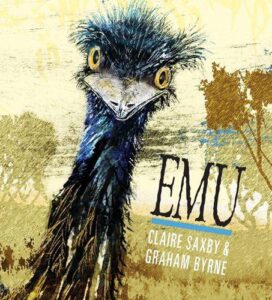 Emu
Emu
By Claire Saxby
Illustrated by Graham Byrne
Candlewick Press
$16.99
ISBN: 978-0-7636-7479-3
Ages 4-7
On shelves now.
Alas for poor emu. Forever relegated to be consider a second rate ostrich, it encompasses all of the awkwardness and none of the stereotypes. Does anyone ever talk about burying your head in the sand like an emu? They do not. Are schoolchildren routinely called upon to ooh and aah at the size of an emu’s egg? They aren’t. And when you watch Swiss Family Robinson, do you ever find yourself wishing that the kids would try to saddle an emu for the big race? Not even once. Emus are the second largest living bird in terms of height, coming right after the ostrich, and you might be fooled into believing that they are the less interesting of the two. There, you are wrong. Wrongdy wrongdy wrong wrong wrong. I do not wish to start a war of words with the prominent ostrich societies of the world, but after reading Emu by Claire Saxby (illustrated by Graham Byrne) I’m a bit of what you might consider an emu convert. Chock full of interesting information and facts about what a typical emu might experience in its day-to-day life, the book is full of thrills, chills, and a species that gives stay-at-home dads everywhere a true animal mascot.
Meet the emu. Do not be offended if he fails to rise when you approach. At the moment he is safeguarding a precious clutch of eggs from elements and predators. While many of us consider the job of hatching eggs to be something that falls to the female of the species, emus are different. Once they’ve laid their eggs, female emus just take off, and it is the male emu that hatches and rears them. In this particular example, the male emu has a brood of seven or so chicks but though they’re pretty big (ten times bigger than a domestic chicken hatchling) they need their dad for food, shelter, and protection. The chicks find their own food right from the start and within three to four months they’ve already lost their first feathers. They zigzag to escape predators, live with their fathers for about a year, and have a kick like you would not believe. Backmatter of the book provides more information about emus, as well as an index.
 This is not what you might call Saxby and Byrne’s first rodeo show. The Aussie duo previously had paired together on the book Big Red Kangaroo, a book that did just fine for itself. Following a kangaroo called “Red”, the ostensibly nonfiction title was best described by PW as, “An understated but visually arresting portrait of a species.” For my part I had no real objections to the book, but neither did I have anything for it. Kangaroo books are not rare in my children’s rooms, though the book was different in that it was written for a younger reading level. That same reading level is the focus of Emu and here I feel that Saxby and Byrne have started to refine their technique. One of the problems I had with Red was this naming of the titular kangaroo. It felt false in a way. Like the author didn’t trust the readers enough to show them a typical day in the life of an animal without having to personalize it with faux monikers. Byrne’s art too felt flatter to me in that book than it does here. This may have more to do with the subject matter than anything else, though. Emu faces, after all, are inherently more amusing and interesting than kangaroos
This is not what you might call Saxby and Byrne’s first rodeo show. The Aussie duo previously had paired together on the book Big Red Kangaroo, a book that did just fine for itself. Following a kangaroo called “Red”, the ostensibly nonfiction title was best described by PW as, “An understated but visually arresting portrait of a species.” For my part I had no real objections to the book, but neither did I have anything for it. Kangaroo books are not rare in my children’s rooms, though the book was different in that it was written for a younger reading level. That same reading level is the focus of Emu and here I feel that Saxby and Byrne have started to refine their technique. One of the problems I had with Red was this naming of the titular kangaroo. It felt false in a way. Like the author didn’t trust the readers enough to show them a typical day in the life of an animal without having to personalize it with faux monikers. Byrne’s art too felt flatter to me in that book than it does here. This may have more to do with the subject matter than anything else, though. Emu faces, after all, are inherently more amusing and interesting than kangaroos
In terms of the text, Saxby utilizes a technique that’s proven very popular with teachers as of late. When kids in classrooms are given open reading time there can sometimes be a real range in reading levels. With this in mind, sometimes nonfiction picture books about the natural world will contain two types of text. There will be the more enticing narrative, ideal for reading aloud to a group or one-on-one. Then, for those budding naturalists, there will be a complementary second section that contains the facts. On the first two pages of Emu, for example, one side introduces the open forest with its “honey-pale sunshine” and the emu’s job while the second block of text, written in a small font that brings to mind an expert’s crisp clean handwriting, gives the statistics about emu (whether or not they can fly, their weight, height, etc.). In the back of the book under the Index there’s actually a little note about these sections. It says, “Don’t forget to look at both kinds of words”, and then writes the words “this kind and this kind” in the two different fonts.
 Artist Graham Byrne’s bio says that he’s an electrical engineer, builder, and artist. This is his second picture book and the art is rendered digitally. What it looks like is scratchboard art, with maybe an ink overlay as well. I enjoyed the sense of place and the landscapes but what really made me happy was how Byrne draws an emu. There’s something about that bright yellow eye in the otherwise impassive face that gets me. I say impassive, but there are times when one wonders if Byrne is fighting an instinct to give his emu some expression. There’s a scene of the emu nosing his eggs, his beak appears to be curling up in just the slightest of smiles. Later an eagle threatens his brood and there’s almost a hint of a frown as he runs over to the rescue. It’s not enough to take you out of the story, but such images bear watching.
Artist Graham Byrne’s bio says that he’s an electrical engineer, builder, and artist. This is his second picture book and the art is rendered digitally. What it looks like is scratchboard art, with maybe an ink overlay as well. I enjoyed the sense of place and the landscapes but what really made me happy was how Byrne draws an emu. There’s something about that bright yellow eye in the otherwise impassive face that gets me. I say impassive, but there are times when one wonders if Byrne is fighting an instinct to give his emu some expression. There’s a scene of the emu nosing his eggs, his beak appears to be curling up in just the slightest of smiles. Later an eagle threatens his brood and there’s almost a hint of a frown as he runs over to the rescue. It’s not enough to take you out of the story, but such images bear watching.
In comparing the emu to the ostrich I may have omitted certain pertinent details. After all, the emu doesn’t have it quite so bad. It appears on the Australian coat of arms, as well as on their money. There was an Emu War of 1932 where the emus actually won the day. Heck, it’s even not too difficult to find emus on farms in the United States. Still, culturally they’ve a far ways to go if ever they are to catch up with their ostrichy brethren fame-wise. Books like this one will help. I think there must be plenty of teachers out there a little tired of using Eric Carle’s Mister Seahorse as their de facto responsible-dads-in-the-wild motif. Now kids outside of Australia will get a glimpse of this wild, wacky, wonderful and weird creature. Consider it worth meeting.
On shelves now.
Source: Final copy sent from publisher for review.
Like This? Then Try:


By:
Betsy Bird,
on 9/9/2015
Blog:
A Fuse #8 Production
(
Login to Add to MyJacketFlap)
JacketFlap tags:
2015 Sibert Award contender,
Best Books of 2015,
Reviews 2015,
2015 reviews,
2015 nonfiction,
2015 nonfiction picture books,
2015 biography,
Reviews,
nonfiction,
Don Tate,
Chris Barton,
nonfiction picture books,
biographies,
Best Books,
Eerdmans Books for Young Readers,
picture book biographies,
Add a tag
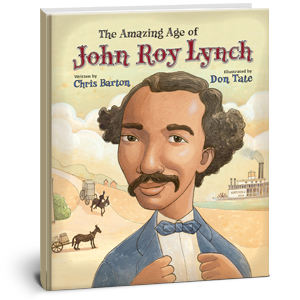 The Amazing Age of John Roy Lynch
The Amazing Age of John Roy Lynch
By Chris Barton
Illustrated by Don Tate
Eerdmans Books for Young Readers
$17.00
ISBN: 978-0-8028-5379-0
Ages 4-8
On shelves now
“It’s the story of a guy who in ten years went from teenage field slave to U.S. Congressman.” Come again? That’s the pitch author Chris Barton pulled out when he wanted to describe this story to others. You know, children’s book biographies can be very easy as long as you cover the same fifteen to twenty people over and over again. And you could forgive a child for never imagining that there were remarkable people out there beyond Einstein, Tubman, Jefferson, and Sacajawea. People with stories that aren’t just unknown to kids but to whole swaths of adults as well. So I always get kind of excited when I see someone new out there. And I get extra especially excited when the author involved is Chris Barton. Here’s a guy who performed original research to write a picture book biography of the guys who invented Day-Glo colors (The Day-Glo Brothers) so you know you’re in safe hands. The inclusion of illustrator Don Tate was not something I would have thought up myself, but by gum it turns out that he’s the best possible artist for this story! Tackling what turns out to be a near impossible task (explaining Reconstruction to kids without plunging them into the depths of despair), this keen duo present a book that reads so well you’re left wondering not just how they managed to pull it off, but if anyone else can learn something from their technique.
From birth until the age of sixteen John Roy Lynch was a slave. The son of an overseer who died before he could free his family, John Roy began life as a house slave but was sent to the fields when his high-strung mistress made him the brunt of her wrath. Not long after, The Civil War broke out and John Roy bought himself a ride to Natchez and got a job. He started out as a waiter than moved on to pantryman, photographer, and in time orator and even Justice of the Peace. Then, at twenty-four years of age, John Roy Lynch was elected to the Mississippi House of Representatives where he served as Speaker of the House. The year was 1869, and these changes did not pass without incident. Soon an angry white South took its fury out on its African American population and the strides that had been made were rescinded violently. John Roy Lynch would serve out two terms before leaving office. He lived to a ripe old age, dying at last in 1939. A Historical Note, Timeline, Author’s Note, Illustrator’s Note, Bibliography of books “For Further Reading”, and map of John’s journey and the Reconstructed United States circa 1870 appear at the end.
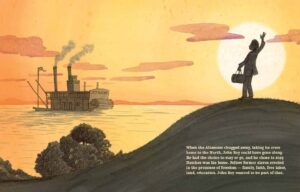 How do you write a book for children about a time when things were starting to look good and then plummeted into bad for a very very long time? I think kids have this perception (oh heck, a bunch of adults too) that we live in the best of all possible worlds. For example, there’s a children’s book series called Infinity Ring where the basic premise is that bad guys have gone and changed history and now it’s up to our heroes to put everything back because, obviously, this world we live in right now is the best. Simple, right? Their first adventure is to make sure Columbus “discovers” America so . . . yup. Too often books for kids reinforce the belief that everything that has happened has to have happened that way. So when we consider how few books really discuss Reconstruction, it’s not exactly surprising. Children’s books are distinguished, in part, by their capacity to inspire hope. What is there about Reconstruction to cause hope at all? And how do you teach that to kids?
How do you write a book for children about a time when things were starting to look good and then plummeted into bad for a very very long time? I think kids have this perception (oh heck, a bunch of adults too) that we live in the best of all possible worlds. For example, there’s a children’s book series called Infinity Ring where the basic premise is that bad guys have gone and changed history and now it’s up to our heroes to put everything back because, obviously, this world we live in right now is the best. Simple, right? Their first adventure is to make sure Columbus “discovers” America so . . . yup. Too often books for kids reinforce the belief that everything that has happened has to have happened that way. So when we consider how few books really discuss Reconstruction, it’s not exactly surprising. Children’s books are distinguished, in part, by their capacity to inspire hope. What is there about Reconstruction to cause hope at all? And how do you teach that to kids?
Barton’s solution is clever because rather than write a book about Reconstruction specifically, he’s found a historical figure that guides the child reader effortlessly through the time period. Lynch’s life is perfect for every step of this process. From slavery to a freedom that felt like slavery. Then slow independence, an education, public speaking, new responsibilities, political success, two Congressional terms, and then an entirely different life after that (serving in the Spanish-American War as a major, moving to Chicago, dying). Barton shows his rise and then follows his election with a two-page spread of KKK mayhem, explaining that the strides made were taken back “In a way, the Civil War wasn’t really over. The battling had not stopped.” And after quoting a speech where Lynch proclaims that America will never be free until “every man, woman, and child can feel and know that his, her, and their rights are fully protected by the strong arm of a generous and grateful Republic,” Barton follows it up with, “If John Roy Lynch had lived a hundred years (and he nearly did), he would not have seen that come to pass.” Barton guides young readers to the brink of the good and then explains the bad, giving context to just how long the worst of it continued. He also leaves it up to them to determine if Lynch’s dream has come to fruition or not (classroom debate time!).
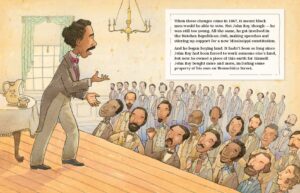 And he plays fair. These days I read nonfiction picture books with my teeth clenched. Why? Because I’ve started holding them to high standards (doggone it). And there are so many moments in this book that could have been done incorrectly. Heck, the first image you see when you open it up is of John Roy Lynch’s family, his white overseer father holding his black wife tenderly as their kids stand by. I saw it and immediately wondered how we could believe that Lynch’s parents ever cared for one another. Yet a turn of the page and Barton not only puts Patrick Lynch’s profession into context (“while he may have loved these slaves, he most likely took the whip to others”) but provides information on how he attempted to buy his wife and children. Later there is some dialogue in the book, as when Lynch’s owner at one point joshes with him at the table and John Roy makes the mistake of offering an honest answer. Yet the dialogue is clearly taken from a text somewhere, not made up to fit the context of the book. I loathe faux dialogue, mostly because it’s entirely unnecessary. Barton shows clearly that one need never rely upon it to make a book exemplary.
And he plays fair. These days I read nonfiction picture books with my teeth clenched. Why? Because I’ve started holding them to high standards (doggone it). And there are so many moments in this book that could have been done incorrectly. Heck, the first image you see when you open it up is of John Roy Lynch’s family, his white overseer father holding his black wife tenderly as their kids stand by. I saw it and immediately wondered how we could believe that Lynch’s parents ever cared for one another. Yet a turn of the page and Barton not only puts Patrick Lynch’s profession into context (“while he may have loved these slaves, he most likely took the whip to others”) but provides information on how he attempted to buy his wife and children. Later there is some dialogue in the book, as when Lynch’s owner at one point joshes with him at the table and John Roy makes the mistake of offering an honest answer. Yet the dialogue is clearly taken from a text somewhere, not made up to fit the context of the book. I loathe faux dialogue, mostly because it’s entirely unnecessary. Barton shows clearly that one need never rely upon it to make a book exemplary.
Finally, you just have to stand in awe of Barton’s storytelling. Not making up dialogue is one thing. Drawing a natural link between a life and the world in which that life lived is another entirely. Take that moment when John Roy answers his master honestly. He’s banished to hard labor on a plantation after his master’s wife gets angry. Then Barton writes, “She was not alone in rage and spite and hurt and lashing out. The leaders of the South reacted the same way to the election of a president – Abraham Lincoln – who was opposed to slavery.” See how he did that? He managed to bring the greater context of the times in line with John Roy’s personal story. Many is the clunky picture book biography that shoehorns in the era or, worse, fails to mention it at all. I much preferred Barton’s methods. There’s an elegance to them.
I’ve been aware of Don Tate for a number of years. No slouch, the guy’s illustrated numerous children’s books, and even wrote (but didn’t illustrate) one that earned him an Ezra Jack Keats New Writer Honor Award (It Jes’ Happened: When Bill Traylor Started to Draw). His is a seemingly simple style. I wouldn’t exactly call it cartoony, but it is kid friendly. Clear lines. Open faces. His watercolors go for honesty and clarity and do not come across as particularly evocative. But I hadn’t ever seen the man do nonfiction, I’ll admit. And while it probably took me a page or two to understand, once I realized why Don Tate was the perfect artist for “John Roy Lynch” it all clicked into place. You see, books about slavery for kids usually follow a prescribed pattern. Some of them go for hyperrealism. Books with art by James Ransome, Eric Velasquez, Floyd Cooper, or E.B Lewis all adhere closely to this style. Then there are the books that are a little more abstract. Books with art by R. Gregory Christie, for example, traipse closely to art worthy of Jacob Lawrence. And Shane W. Evans has a style that’s significantly artistic. A more cartoony style is often considered too simplistic for the heavy subject matter or, worse, disrespectful. But what are we really talking about here? If the book is going to speak honestly about what slavery really was, the subjugation of whole generations of people, then art that hews closely to the truth is going to be too horrific for kids. You need someone who can cushion the blow, to a certain extent. It isn’t that Tate is shying away from the horrors. But when he draws it it loses some of its worst terrors. There is one two-page spread in this book that depicts angry whites whipping and lynching their black neighbors.  It’s not shown as an exact moment in time, but rather a composite of events that would have happened then. And there’s something about Tate’s style that makes it manageable. The whip has not yet fallen and the noose has not yet been placed around a neck, but the angry mobs are there and you know that the worst is imminent. Most interesting to me too is that far in the background a white woman and her two children just stand there, neither approving nor condemning the action. I think you could get a very good conversation out of kids about this family. What are they feeling? Whose side are they on? Why don’t they do something?
It’s not shown as an exact moment in time, but rather a composite of events that would have happened then. And there’s something about Tate’s style that makes it manageable. The whip has not yet fallen and the noose has not yet been placed around a neck, but the angry mobs are there and you know that the worst is imminent. Most interesting to me too is that far in the background a white woman and her two children just stand there, neither approving nor condemning the action. I think you could get a very good conversation out of kids about this family. What are they feeling? Whose side are they on? Why don’t they do something?
And Tate has adapted his style, you can see. Compare the heads and faces in this book to those in one of his earlier books like, Ron’s Big Mission by Rose Blue, in this one he modifies the heads, making them a bit smaller, in proportion with the rest of the body. I was particularly interested in how he did faces as well. If you watch Lynch’s face as a child and teen it’s significant how he keeps is features blank in the presence of white people. Not expressionless, but devoid of telltale thoughts. As a character, the first time he smiles is when he finally has a job he can be paid for. With its silhouetted moments, good design sense, tapered but not muted color palette, and attention to detail, Mr. Tate puts his all into what is by far his most sophisticated work to date.
This year rage erupted over the fact that the Confederate flag continues to fly over the South Carolina statehouse grounds. To imagine that the story Barton relates here does not have immediate applications to contemporary news is facile. As he mentions in his Author’s Note, “I think it’s a shame how little we question why the civil rights movement in this country occurred a full century following the emancipation of the slaves rather than immediately afterward.” So as an author he found an inspiring, if too little known, story of a man who did something absolutely astounding. A story that every schoolchild should know. If there’s any justice in the universe, after reading this book they will. Reconstruction done right. Nonfiction done well.
On shelves now.
Source: Final copy sent from publisher for review.
Like This? Then Try:
Professional Reviews:
Misc: For you, m’dear? An educator’s guide.
Videos: A book trailer and everything!


By:
Betsy Bird,
on 7/1/2015
Blog:
A Fuse #8 Production
(
Login to Add to MyJacketFlap)
JacketFlap tags:
Reviews,
nonfiction picture books,
Scholastic,
Best Books,
Arthur A. Levine,
Sean Qualls,
Selina Alko,
Best Books of 2015,
Reviews 2015,
2015 reviews,
2015 nonfiction picture books,
Add a tag
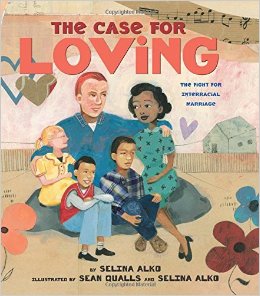 The Case for Loving: The Fight for Interracial Marriage
The Case for Loving: The Fight for Interracial Marriage
By Selina Alko
Illustrated by Sean Qualls
Arthur A. Levine Books (an imprint of Scholastic)
$18.99
ISBN: 978-0545478533
Ages 4-7
On shelves now.
When the Supreme Court ruled on June 26, 2015 that same-sex couples could marry in all fifty states, I found myself, like many parents of young children, in the position of trying to explain the ramifications to my offspring. Newly turned four, my daughter needed a bit of context. After all, as far as she was concerned gay people had always had the right to marry so what exactly was the big deal here? In times of change, my back up tends to be children’s books that discuss similar, but not identical, situations. And what book do I own that covers a court case involving the legality of people marrying? Why, none other than The Case for Loving: The Fight for Interracial Marriage by creative couple Selina Alko and Sean Qualls. It’s almost too perfect that the book has come out the same year as this momentous court decision. Discussing the legal process, as well as the prejudices of the time, the book offers to parents like myself not just a window to the past, but a way of discussing present and future court cases that involve the personal lives of everyday people. Really, when you take all that into consideration, the fact that the book is also an amazing testament to the power of love itself . . . well, that’s just the icing on the cake.
In 1958 Richard Loving, a white man, fell in love with Mildred Jeter, a black/Native American woman. Residents of Virginia, they could not marry in their home state so they did so in Washington D.C. instead. Then they turned right around and went home to Virginia. Not long after they were interrupted in the night by a police invasion. They were charged with “unlawful cohabitation” and were told in no uncertain terms that if they were going to continue living together then they needed to leave Virginia. They did, but they also hired lawyers to plead their case. By 1967 the Lovings made it all the way to The Supreme Court where their lawyers read a prepared statement from Richard. It said, “Tell the court I love my wife, and it is just unfair that I can’t live with her in Virginia.” In a unanimous ruling, the laws restricting such marriages were struck down. The couple returned to Virginia, found a new house, and lived “happily (and legally) ever after.” An Author’s Note about her marriage to Sean Qualls (she is white and he is black) as well as a note about the art, Sources, and Suggestions for Further Reading appear at the end of the book.
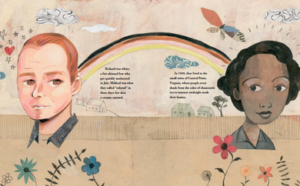 “How do you sue someone?” Here’s a challenge. Explain the concept of suing the government to a four-year-old brain. To do so, you may have to explain a lot of connected concepts along the way. What is a lawyer? And a court? And, for that matter, why are the laws (and cops) sometimes wrong? So when I pick up a book like The Case for Loving as a parent, I’m desperately hoping on some level that the authors have figured out how to break down these complex questions into something small children can understand and possibly even accept. In the case of this book, the legal process is explained as simply as possible. “They wanted to return to Virginia for good, so they hired lawyers to help fight for what was right.” And then later, “It was time to take the Loving case all the way to The Supreme Court.” Now the book doesn’t explain what The Supreme Court was necessarily, and that’s where the art comes in. Much of the heavy lifting is done by the illustrations, which show the judges sitting in a row, allowing parents like myself the chance to explain their role. Here you will not find a deep explanation of the legal process, but at least it shows a process and allows you to fill in the gaps for the young and curious.
“How do you sue someone?” Here’s a challenge. Explain the concept of suing the government to a four-year-old brain. To do so, you may have to explain a lot of connected concepts along the way. What is a lawyer? And a court? And, for that matter, why are the laws (and cops) sometimes wrong? So when I pick up a book like The Case for Loving as a parent, I’m desperately hoping on some level that the authors have figured out how to break down these complex questions into something small children can understand and possibly even accept. In the case of this book, the legal process is explained as simply as possible. “They wanted to return to Virginia for good, so they hired lawyers to help fight for what was right.” And then later, “It was time to take the Loving case all the way to The Supreme Court.” Now the book doesn’t explain what The Supreme Court was necessarily, and that’s where the art comes in. Much of the heavy lifting is done by the illustrations, which show the judges sitting in a row, allowing parents like myself the chance to explain their role. Here you will not find a deep explanation of the legal process, but at least it shows a process and allows you to fill in the gaps for the young and curious.
It was very interesting to me to see how Alko and Qualls handled the art in this book. I’ve often noticed that editors like to choose Sean as an artist when they want an illustrator that can offset some of the darker aspects of a work. For example, take Margarita Engle’s magnificently sordid Pura Belpre Medal winner The Poet Slave of Cuba. A tale of torture, gore, and hope, Qualls’ art managed to represent the darkness with a lighter touch, while never taking away from the important story at hand. In The Case for Loving he has scaled the story down a bit and given it a simpler edge. His characters are a bit broader and more cartoonlike than those in, say, Dizzy. This is due in part to Alko’s contributions. As they say in their “About the Art” section at the back of the book, Alko’s art is all about bold colors and Sean’s is about subtle layers of color and texture. Together, they alleviate the tension in different scenes. Moments that could be particularly frightening, as when the police burst into the Lovings’ bedroom to arrest them, are cast instead as simply dramatic. I noticed too that characters were much smaller in this book than they tend to be in Sean’s others. It was interesting to note the moments when that illustrators made the faces of Richard and Virginia large. The page early in the book where Richard and Mildred look at one another over the book’s gutter pairs well with the page later in the book where their faces appear on posters behind bars against the words “Unlawful Cohabitation”. But aside from those two double spreads the family is small, often seen just outside their different respective homes. It seemed to be important to Qualls and Alko to show them as a family unit as often as possible.
 Few books are perfect, and Loving has its off-kilter moments from time to time. For example, it describes darker skin tones in terms of food. That’s not a crime, of course, but you rarely hear white skin described as “white as aged cheese” or “the color of creamy mayonnaise” so why is dark colored skin always edible? In this book Mildred is “a creamy caramel” and she lives where people ranged from “the color of chamomile tea” to darker shades. A side issue has arisen concerning Mildred’s identification as Native American and whether or not the original case made more of her African-American roots because it would build a stronger case in court. This is a far bigger issue than a picture book could hope to encompass, though I would be interested in a middle grade or young adult nonfiction book on the topic that went into the subject in a little more depth.
Few books are perfect, and Loving has its off-kilter moments from time to time. For example, it describes darker skin tones in terms of food. That’s not a crime, of course, but you rarely hear white skin described as “white as aged cheese” or “the color of creamy mayonnaise” so why is dark colored skin always edible? In this book Mildred is “a creamy caramel” and she lives where people ranged from “the color of chamomile tea” to darker shades. A side issue has arisen concerning Mildred’s identification as Native American and whether or not the original case made more of her African-American roots because it would build a stronger case in court. This is a far bigger issue than a picture book could hope to encompass, though I would be interested in a middle grade or young adult nonfiction book on the topic that went into the subject in a little more depth.
Recently I read my kid another nonfiction picture book chronicling injustice called Drum Dream Girl by the aforementioned Margarita Engle. In that book a young girl isn’t allowed to drum because of her gender. My daughter was absolutely flabbergasted by the notion. When I read her The Case for Loving she was similarly baffled. And when, someday, someone writes a book about the landmark decision made by The Supreme Court to allow gay couples to wed, so too will some future child be just as floored by what seems completely normal to them. Until then, this is certainly a book written and published at just the right time. Informative and heartfelt all at once, it works beyond the immediate need. Context is not an easy thing to come by when we discuss complex subjects with our kids. It takes a book like this to give us the words we so desperately need. Many thanks then for that.
On shelves now.
Source: Galley sent from publisher for review.
Like This? Then Try:
Misc: Don’t forget to check out this incident that occurred involving this book and W. Kamau Bell’s treatment at Berkeley’s Elmwood Café.


By:
Betsy Bird,
on 5/9/2015
Blog:
A Fuse #8 Production
(
Login to Add to MyJacketFlap)
JacketFlap tags:
Best Books of 2015,
Reviews 2015,
2015 reviews,
2015 nonfiction,
2015 nonfiction picture books,
2016 Sibert Award candidate,
Lindsay Mattick,
Reviews,
nonfiction,
nonfiction picture books,
Winnie-the-Pooh,
Sophie Blackall,
Little Brown and Company,
Add a tag
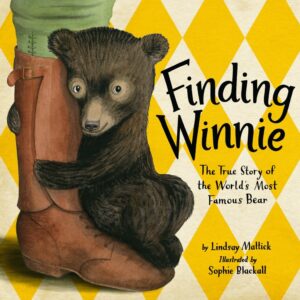 Finding Winnie: The True Story of the World’s Most Famous Bear
Finding Winnie: The True Story of the World’s Most Famous Bear
By Lindsay Mattick
Illustrated by Sophie Blackall
$18.00
ISBN: 978-0-316-32490-8
Ages 4-7
On shelves October 20th
What is it with bears and WWI? Aw, heck. Let’s expand that question a tad. What is it with adorable animals and WWI? Seems these days no matter where you turn you find a new book commemorating a noble creature’s splendor and sacrifice on the battlefields of Europe. If it’s not Midnight, A True Story of Loyalty in World War I by Mark Greenwood or Stubby the War Dog: The True Story of WWI’s Bravest Dog by Ann Bausum, it’s Voytek, the Polish munitions bear in Soldier Bear or, best known of them all, the inspiration for Winnie-the-Pooh. With the anniversary of WWI here, the children’s literary sphere has witnessed not one but two picture book biographies of Winnie, the real bear that inspired Christopher Robin Milne and, in turn, his father A.A. Milne. The first of these books was Winnie: The True Story of the Bear That Inspired Winnie-the-Pooh by Sally M. Walker. A good strong book, no bones about it. But Finding Winnie has an advantage over the Walker bio that cannot be denied. One book was researched and thought through carefully. The other? Written by one of the descendants of the veterinarian that started it all. Add in the luminous artwork of Sophie Blackall and you’ve got yourself a historical winner on your hands.
Now put yourself in Harry’s shoes. You’re suited up. You’re on a train. You’re headed to training for the Western Front where you’ll be a service vet, aiding the horses there. The last thing you should do is buy a baby bear cub at a train station, right? I suppose that was the crazy thing about Harry, though. As a vet he had the skills and the knowledge to make his plan work. And as for the bear, she was named Winnipeg (or just Winnie for short), and she instantly charmed Harry’s commanding officer and all his fellow soldiers. During training she was great for morale, and before you knew it she was off with the troop overseas. But with the threat of real combat looming, Harry had a difficult decision to make. This little bear wasn’t suited for the true horrors of war. Instead, he dropped her off at The London Zoo where she proceeded to charm adults and children alike. That was where she made the acquaintance of Christopher Robin Milne and inspired the name of the world’s most famous stuffed animal. Framed within the context of author Lindsay Mattick telling this story to her son Cole, Ms. Mattick deftly weaves a family story in with a tale some might know but few quite like this.
Right from the start I was intrigued by the book’s framing sequence. Here we have a bit of nonfiction for kids, and yet all throughout the book we’re hearing Cole interjecting his comments as his mother tells him this story. It’s a unique way of presenting what is already an interesting narrative in a particularly child-friendly manner. But why do it at all? What I kept coming back to as I read the book was how much it made the story feel like A.A. Milne’s. Anyone who has attempted to read the first Winnie-the-Pooh book to their small children will perhaps be a bit surprised by the extent to which Christopher Robin’s voice keeps popping up, adding his own color commentary to the proceedings. Cole’s voice does much the same thing, and once I realized that Mattick was playing off of Milne’s classic, other Winnie-the-Pooh callbacks caught my eye. There’s the Colonel’s surprised “Hallo” when he first meets Winnie, which struck me as a particularly Pooh-like thing to say. There are the comments between Harry’s heart and head which reminded me, anyway, of Pooh’s conversations with his stomach. They are not what I would call overt callbacks but rather like subtle little points of reference for folks who are already fans.
I was struck my Mattick’s attention to accuracy and detail too. The temptation in these sorts of books is to fill them up with fake dialogue. One might well imagine that the conversation with Cole is based on actual conversations, possibly culled together from a variety of different accounts. Since Mattick isn’t saying this-happened-like-this-on-precisely-this-date we can enjoy it for what it is. As for Harry’s tale, you only occasionally get a peek into his brain and when you do it’s in his own words, clearly taken from written accounts. Mattick does not divulge these accounts, sadly, so there’s nothing in the back of the book so useful as a Bibliography. However, that aside, the book rings true. So much so that it almost makes me doubt other accounts I’ve read.
As for the text itself, I was mildly surprised by how good the writing was. Mattick makes some choices that protect the young readers while keeping the text accurate. For example, when little Cole asks what trappers, like the one who killed Winnie’s mother, do, Lindsay’s answer is to say, “It’s what trappers don’t do. They don’t raise bears.” Hence, Harry had to buy it. She also has a nice little technique, which I alluded to earlier, where Harry’s heart and mind are at odds. The heart allows him to buy Winnie and take her overseas. The mind wins in terms of taking her to The London Zoo in the end.
I like to put myself in the place of the editor of this book. The manuscript has come in. I like it. I want to publish it. I get the thumbs up from my publisher to go ahead and then comes the part where I find an illustrator for it. I want somebody who can emote. Someone just as adept at furry baby bear cubs as they are soldiers in khaki with teeny tiny glasses. But maybe I want something more. Maybe I want an illustrator who puts in the rudimentary details, then adds their own distinctive style to the mix. I’m willing to get an artist who could potentially overshadow the narrative with visual beauty. In short, I want a Sophie Blackall.
Now I’ve heard Ms. Blackall speak on a couple occasions about the meticulous research she conducted for this book. The Canadian flag she initially mistakenly placed on a ship of war has been amended from an earlier draft (the Canadian flag wasn’t officially adopted until 1965). She researched The London Zoo for an aerial shot that includes everything from the squirrel enclosure to Winnie’s small block of concrete or stone. Blackall also includes little visual details that reward multiple readings. A scene where Harry departs on the train, surrounded by people saying goodbye, is contrasted by a later scene where he returns and far fewer people are saying hello to their loved ones. One soldier has lost a leg. Another greets his much larger son and perpetually handkerchief clutching wife. Another doesn’t appear at all. And finally, Blackall throws in beautiful two-page spreads for the sake of beauty alone. The initial endpapers show an idyllic woodland scene, presumably in Canada. Later we’ve this red sky scene of the ship proceeding across the Atlantic Ocean to Europe. For a book about WWI, that red is the closest we come (aside from the aforementioned missing leg) to an allusion to the bloody conflict happening elsewhere. It’s beautiful and frightening all at once.
In the world of children’s literature you never get a single book on the subject and then say, “There! Done! We don’t need any more!” It doesn’t matter how great a book is, there’s always room for another. And it seems to me that on the topic of Winnie the bear, friend of Christopher Robin, inspiration to a platoon, there is plenty of wiggle room. Hers is a near obscure tale that is rapidly becoming better and better known each day. I think that this pairs magnificently with Walker’s Winnie. For bear enthusiasts, Winnie enthusiasts, history lovers, and just plain old folks who like a good story. In short, for silly old bears.
On shelves October 20th.
Source: F&G sent from publisher for review.
Like This? Then Try:


By:
Betsy Bird,
on 3/26/2015
Blog:
A Fuse #8 Production
(
Login to Add to MyJacketFlap)
JacketFlap tags:
Best Books of 2015,
Reviews 2015,
2015 reviews,
2015 nonfiction,
2015 biography,
2016 Sibert Award candidate,
Reviews,
nonfiction,
nonfiction picture books,
biographies,
Best Books,
picture book biographies,
Add a tag
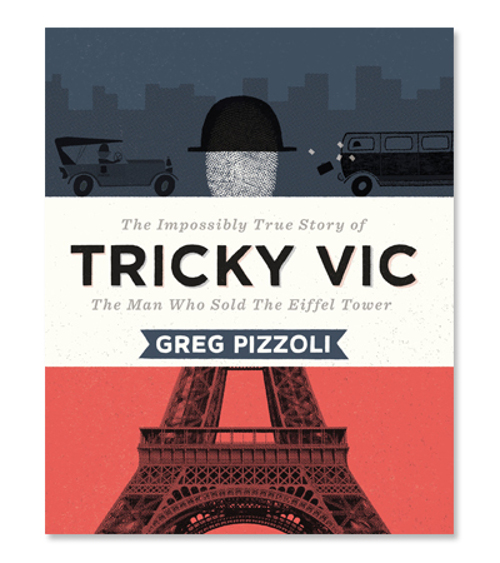 Tricky Vic: The Impossibly True Story of the Man Who Sold the Eiffel Tower
Tricky Vic: The Impossibly True Story of the Man Who Sold the Eiffel Tower
By Greg Pizzoli
Viking (an imprint of Penguin Group USA)
$17.99
ISBN: 978-0-670-01652-5
Ages 8-11
On shelves now
I was listening to a favorite podcast of mine the other day when the panelists began discussing the difference between heist films and con man films. A heist film is one where the entire movie is a build-up to a great and fabulous heist. Ocean’s 11 and that sort of thing. In the children’s book world this would be The Great Greene Heist. A con man film is different. There you have a single individual, and not necessarily a heroic one either. Catch Me If You Can is a con man film. And on the children’s book side? Honestly, we don’t have a lot of them. Maybe Pickle by Kim Baker but that’s a stretch. It really wasn’t until I laid eyes on Greg Pizzoli’s Tricky Vic that I could appreciate what I had been missing all these years. Told with a relaxed easygoing style, Pizzoli takes one of the world’s most notorious individuals in the con game, and refuses to humanize him. Here we see a character that was larger than life. Makes sense that he’d try to sell a structure that was in many ways his equal.
In 1890 he was born Robert Miller, but that didn’t last. Names came and went and by the time he was an adult, Miller was a professional gambler turned con artist. His preferred method of payment was gambling on transatlantic ocean liners but then along came WWI and Miller, now calling himself Count Victor Lustig, needed a new occupation. Through a little low level trickery he got the blessing of Al Capone and then set about bilking the easy rich. But his greatest feat, and the one that would put him down in the history books, was his successful con of “selling” the Eiffel Tower to prospective buyers. Though in time he was eventually caught and jailed (in Alcatraz, no less), Vic’s odd life shines a spotlight on those individuals willing to get ahead on our own greed and misplaced hope. Backmatter includes an Author’s Note, Glossary, Selected Sources, and a note on the art.
Every great picture book biography finds something about an individual that is interesting to child readers. In The Boy Who Loved Math it was Paul Erdos’s sheer enthusiasm and childlike goofiness. In The Noisy Paintbox it was Kandinsky’s ability to translate sound to sight and back again. And in Tricky Vic it’s shamelessness. Kids don’t often encounter, in any form, adults that unapologetically do wrong. Vic ultimately pays for his crimes, and in many ways that’s the only way you can get away with what Pizzoli is doing here. You see, the trouble with con man storylines is that they’re just too much fun. You can’t help but root for Vic when he pulls the old Romanian Money Box scheme or when he cons the great Al Capone himself. Really one of the few objections I’ve heard lobbed against the book is a question as to whether or not kids will have any interest in an obscure two-bit criminal. But like all great nonfiction authors for kids, Pizzoli knows that children’s biographies do not begin and end with Amelia Earhart and Abraham Lincoln. Sometimes kids appreciate far more the biographies of the people who didn’t go about with halos hovering around their ears. There’s room on our shelves for the baddies.
Now when Greg Pizzoli debuted with his picture book The Watermelon Seed two years ago, there was nothing to indicate to me that he had any inclination to go the nonfiction route. “The Watermelon Seed” utilizes a three-color print job and distinctly retro aesthetic. That aesthetic remains intact in Tricky Vic but Pizzoli but the technique has been cranked up to eleven. In “A Note About the Art in This Book” at the back, Pizzoli says that the illustrations seen here were “created using pencil, ink, rubber stamps, halftone photographs, silkscreen, Zipatone, and Photoshop.” The end result is a book that straddles the line between those picture books actually concocted in the 1930s and a distinctly contemporary creation.
Dig a little deeper and Pizzoli’s illustration choices go beyond mere novelty. The choice to render Vic’s head as a thumbprint has so many different uses. With a mere change in tone or color, Pizzoli can render his personality and character different from one page to the next. This chameleon of a man couldn’t ask for better representation. But much of the success of the book lies in how it tackles the question of Vic as a bad person. Pizzoli’s choice to make Vic expressionless throughout the book is key to this. Because kids aren’t exactly reading about a role model, it’s important that Vic never look like he’s having too much fun. Remove his mouth and eyes and voila! An instant blank slate on which to project your storyline. Let the facts speak for themselves.
And speaking of facts, in no time in our nation’s history have picture book biographies for children fallen under as much scrutiny as they do today. Time was the D’Aulaires could write varying fictional accounts of everyone from Pocahontas to Abraham Lincoln and win Caldecotts for their efforts. These days, the debate rages around how much an author is allowed to do and the crux of that debate centers on made up dialogue. I am firmly of the opinion that made up dialogue is unnecessary in a children’s book biography. However, when handled creatively, there are exceptions to every rule. And “Tricky Vic” is, if nothing else, vastly creative. If you read the book the actual text is all factual. There is some mucking about with the timeline of one of the major events in Vic’s life, but Pizzoli comes clean about that in his Author’s Note in the back, and I give a lot of credit to folks who fess up plainly. Getting back to the text, look a little closer and you’ll see that there is some made up dialogue but Pizzoli keeps it at a minimum and gives it its own separate space. Little speech balloons between the characters will occasionally crop up at the bottom of the pages. The feeling is that these are interstitial fictional bits that simply support the rest of the text. A reader doesn’t walk away from them thinking that they’re strict representations of the past. They are, instead, a little colorful complement to the text to give it a lighter bouncier feel.
I recently conducted a Salon in my library on children’s nonfiction picture book illustration and historical accuracy. During the course of the talk we discussed Vincent Kirsch’s work on Gingerbread for Liberty and the times when a bouncier, more light-hearted feel to the illustrations best fit the text. In Tricky Vic Pizzoli isn’t going for a meticulous reconstruction of past events in his art. He’s going for something with a historical feel, but with fun built in as well. The design elements are what really step things up a notch. I also loved the factual sidebars that complemented the text but never dominate. As kids read they encounter sections talking about Prohibition, The Tower’s Critics (the folks who hated it from the get-go, that is), the Hotel de Crillon, Counterfeiting, and Alcatraz. The end result is as dynamic as it is informative.
I wonder vaguely if this book will receive any challenges from concerned parents living in the mistaken belief that Pizzoli has penned a How To manual for little budding criminals. As I mentioned before, the line between celebrating your biographical picture book subject and simply reporting on their life is thin. The beauty of Tricky Vic, I think, is that his life is just as wild and weird as any fictional character. There is value in showing kids the fools of the past. I don’t think anyone will walk away from this thinking Vic had it all figured out, but I do think a fair number of them might want to follow-up on Pizzoli’s Selected Sources for a little independent reading of their own. And if this book encourages just one kid to rethink their attitude towards nonfiction, then this title has earned its place in the world. The gorgeous art and great writing are just gravy. For one. For all. Un-forgettable.
On shelves now.
Source: Final copy sent from publisher for review.
Like This? Then Try:
Other Blog Reviews: 100 Scope Notes
Professional Reviews: The New York Times
Interviews: Greg Pizzoli discusses his technique at Seven Impossible Things Before Breakfast.


By:
Betsy Bird,
on 2/11/2015
Blog:
A Fuse #8 Production
(
Login to Add to MyJacketFlap)
JacketFlap tags:
Reviews,
nonfiction picture books,
Winnie-the-Pooh,
Sally M. Walker,
Reviews 2015,
2015 reviews,
2015 nonfiction,
2015 nonfiction picture books,
Jonathan D. Voss,
Add a tag
 Winnie: The True Story of the Bear That Inspired Winnie-the-Pooh
Winnie: The True Story of the Bear That Inspired Winnie-the-Pooh
By Sally M. Walker
Illustrated by Jonathan D. Voss
Henry Holt (an imprint of Macmillan)
$17.99
ISBN: 978-0805097153
Ages 4-7
On shelves now
I worked in close proximity to the real Winnie-the-Pooh for five years. From 2006 to 2011 he was a daily delight. To clarify, I was working alongside the original Winnie-the-Pooh toys owned by the real Christopher Robin, son of A.A. Milne in New York Public Library’s Central Children’s Room. We had Piglet, Tigger, Kanga (no Roo), Eeyore, and Winnie himself. Though ironically I never read his books as a child, in my time as a children’s librarian working in the Children’s Center at 42nd Street I became well versed in his story. Winnie was purchased at Harrods for Christopher Robin who eventually named him “Winnie” after some bear he’d seen in a zoo. If pressed to conjure up facts about that zoo bear I might have been able to tell you that its name was Winnipeg, but that was about as far as my knowledge on the matter went. Sometimes it takes a children’s book to learn about a children’s book character. Winnie: The True Story of the Bear That Inspired Winnie-the-Pooh relates the true history of a man and his bear. Illustrated with aplomb by Jonathan D. Voss, the book’s charm is the true measure by which you can assess how well it lives up to its namesake. Accuracy and adorableness in one small, furry package.
There are many things Harry Colebourn could have purchased as his troop passed through the small train station, but what did he end up with? A baby bear. A baby black bear, if you want to be precise about it. Good natured and orphaned, Harry promptly names her “Winnie” after his company’s hometown “Winnipeg” and she becomes the darling of his troop. When WWI calls his company across the wide ocean, Winnie comes along. But killing fields are no place for a baby bear so it’s to the London Zoo that Winnie goes. Once there, Harry promises her that when the war is done he’ll take her back to Winnipeg. It’s a promise he doesn’t keep. Upon his return Harry sees that Winnie is not only happy but a star of the zoo. She’s so gentle that children everywhere come to see her. Even a boy by the name of Christopher Robin . . . Copious photographs of the real Winnie and Harry grace the front endpapers while Christopher Robin graces the back. There is an additional Author’s Note on Harry, Winnie, and black bears as well as a Bibliography of sources.
As I began reading the book I wondered if the story of Winnie would be akin to other military animal tales out there. Would Winnie aid the Allies much in the same way as Voytek in Poland or was she more of a mascot like Stubby? Neither, as it happens. Though Winnie did make it onto a boat headed for France, her keeper was smart enough to recognize that while some bears would thrive in a war zone (see: Voytek), Winnie was not one of them. Really she was just a baby and after seeing her playing and cuddling with Harry the thought of her existing in a place where bullets would fly is terrifying. This is a sweet wartime tale, perfect for reading to younger children who take things on face value and aren’t aware of what WWI really entailed.
 The art of Jonathan D. Voss caught me by surprise. With just a half glance at the cover I initially though the illustrator was Amy June Bates (who illustrated the somewhat similar Christian, the Hugging Lion back in 2010). An understandable mistake but once I actually went so far as to, oh I dunno LOOK at the book, I could see that Voss has a crisper line as well as a sure and steady grasp on the material. This being the first picture book that he has illustrated, he does a good job of making some really iconic images. The view on the cover of Harry hugging Winnie to his chest, as one might cuddle an infant, is downright heartwarming. Likewise the image of Winnie asleep under Harry’s cot as his long arm drapes down, his wrist bending in sleep, works. And if the four shots of Harry playing with Winnie were a YouTube video they’d get more hits than any other cute animal video to date. There is the occasional misstep, I’m afraid. A boy riding Winnie later in the book bears the slack-jawed look of a very small grown man and not a little boy. Indeed Voss appears to be most comfortable when Winnie is his focus. There’s not a single image where that bear doesn’t feel 100% authentic. One suspects the artist spent a great deal of time studying baby black bears and how they move. He also does a decent job of rendering the stuffed Pooh accurately. The arms are admittedly a bit long but the stance and nose are on target.
The art of Jonathan D. Voss caught me by surprise. With just a half glance at the cover I initially though the illustrator was Amy June Bates (who illustrated the somewhat similar Christian, the Hugging Lion back in 2010). An understandable mistake but once I actually went so far as to, oh I dunno LOOK at the book, I could see that Voss has a crisper line as well as a sure and steady grasp on the material. This being the first picture book that he has illustrated, he does a good job of making some really iconic images. The view on the cover of Harry hugging Winnie to his chest, as one might cuddle an infant, is downright heartwarming. Likewise the image of Winnie asleep under Harry’s cot as his long arm drapes down, his wrist bending in sleep, works. And if the four shots of Harry playing with Winnie were a YouTube video they’d get more hits than any other cute animal video to date. There is the occasional misstep, I’m afraid. A boy riding Winnie later in the book bears the slack-jawed look of a very small grown man and not a little boy. Indeed Voss appears to be most comfortable when Winnie is his focus. There’s not a single image where that bear doesn’t feel 100% authentic. One suspects the artist spent a great deal of time studying baby black bears and how they move. He also does a decent job of rendering the stuffed Pooh accurately. The arms are admittedly a bit long but the stance and nose are on target.
One objection I’ve heard to the story is that there isn’t enough Christopher Robin / real Winnie-the-Pooh info included in this story. I can see where this critic is coming from but I respectfully disagree. To my mind, Winnie’s story is fascinating in and of itself regardless of what famous literary character she ended up inspiring on some level. Hers is a story of tragedy turned to great good luck. Few orphaned bears in the WWI era would have found such a caring owner, let alone one that let them travel to Europe. Her life was notable at the time and makes for no less an interesting story today.
 For my part, the book gets into tricky territory when we view the quoted dialog. Now Ms. Walker is a known entity. She does this stuff for a living. Wins big nonfiction awards like the Sibert for Secrets of a Civil War Submarine and the like. So when we get to a section where Harry is quoted saying “I’ll feed her condensed milk. She can stay with me in camp. Winnipeg can be our mascot,” then we have to naturally assume that the quote comes from one of the listed sources Walker provides at the back of the book. The quotes are not sourced but since Harry’s diary is one of those aforementioned sources, there’s a strong likelihood that the quotes come from there. I’m giving the book the benefit of the doubt in this matter, since faux dialog is the bane of the modern nonfiction picture book.
For my part, the book gets into tricky territory when we view the quoted dialog. Now Ms. Walker is a known entity. She does this stuff for a living. Wins big nonfiction awards like the Sibert for Secrets of a Civil War Submarine and the like. So when we get to a section where Harry is quoted saying “I’ll feed her condensed milk. She can stay with me in camp. Winnipeg can be our mascot,” then we have to naturally assume that the quote comes from one of the listed sources Walker provides at the back of the book. The quotes are not sourced but since Harry’s diary is one of those aforementioned sources, there’s a strong likelihood that the quotes come from there. I’m giving the book the benefit of the doubt in this matter, since faux dialog is the bane of the modern nonfiction picture book.
Read this book and few will wonder that after seeing Winnie in person, Christopher Robin wanted a bear of his very own. Indeed, the vast majority of children who are read Winnie may think to themselves (or say out loud) at some point, “When do I get my own?” Sorry, kids. If it’s any consolation you can see the Winnie-the-Pooh toys in the main New York Public Library location anytime the building is open. Maybe it won’t be the same as getting to ride a sweet bear in the zoo, but it’s still a part of this story on some level. Cute, not saccharine, and pleasing to boot, this is one story-behind-the-story kids will definitely appreciate. Lovers of Pooh welcome but not required.
On shelves now.
Source: Final copy sent from publisher for review.
Like This? Then Try:
Interviews: Julie Danielson interviews Sally M. Walker about the book over at BookPage.
Misc: For more interior illustrated spreads, go to Seven Impossible Things Before Breakfast.
Video: Forgot a movie was made out of this story as well, didn’t you? You’re forgiven. It came out in 2004 and was made for TV after all. That said, it had some big name cast members. Michael Fassbender starred. Stephen Fry shows up. David Suchet. And someone put the whole thing up on YouTube so if you’ve an hour and a half to kill . . .


By:
Betsy Bird,
on 11/21/2014
Blog:
A Fuse #8 Production
(
Login to Add to MyJacketFlap)
JacketFlap tags:
David Macaulay Studio,
Reviews,
nonfiction,
nonfiction picture books,
Roaring Brook,
Best Books,
macmillan,
Katherine Roy,
Best Books of 2014,
Reviews 2014,
2014 reviews,
2014 nonfiction,
Add a tag
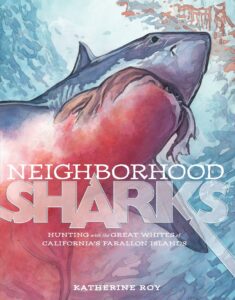 Neighborhood Sharks: Hunting with the Great Whites of California’s Farallon Islands
Neighborhood Sharks: Hunting with the Great Whites of California’s Farallon Islands
By Katherine Roy
David Macaulay Studio – Roaring Brook (Macmillan)
$17.99
ISBN: 9781596438743
Ages 7-12
On shelves now.
When you’re a librarian buying for your system, you come to understand that certain nonfiction topics are perennial favorites. You accept that no matter how many copies you buy, you will never have enough train or joke or magic books. And the king daddy topic to beat them all, the one that leaves a continual gaping hole in the Dewey Decimal area of 597.3 or so, is sharks. Kids can’t get enough of them. Heck, adults can’t get enough of them. Between Shark Week and movies like Sharknado, sharks haven’t been this pop culturally relevant since the good old days of JAWS. And sure, we’ve plenty of truly decent shark books on our shelves already. What we don’t really have are books that combine the blood and the facts with the beauty of full-color, wholly accurate paintings. We’ve never truly had a shark book that’s as accomplished and stunning as Katherine Roy’s Neighborhood Sharks. It’s crazy to contemplate that though shark books are never unpopular, only now did someone take the time and effort to give them a publication worthy of their terror and wonder.
A single great white shark cuts through the waters surrounding San Francisco’s Farallon Islands “just 30 miles from the city”. Prey comes in the form of a fine fat seal and before the mammal realizes what’s happening the shark attacks. What makes a shark the perfect killer? Consider its weapons. Note the body, covered in “skin teeth”, capable of acting like a warm-blooded fish. Observe its high-definition vision and five rows of teeth. Did you know that a shark’s jaws aren’t fused to the skull, so that they can actually be projected forward to bite something? Or the method by which you would go about actually tagging this kind of creature? With candor and cleverness, author/artist Katherine Roy brings these silent killers to breathtaking life. You may never desire to set foot into the ocean again.
It’s hard to imagine a book on sharks that has art that can compete with all those shark books laden with cool photographic images. Roy’s advantage here then is the freedom that comes with the art of illustration. She’s not beholden to a single real shark making a real kill. With her brush she can set up a typical situation in which a great white shark attacks a northern elephant seal. The looming threat of the inevitable attack and the almost Hitchcockian way she sets up her shots (so to speak) give the book a tension wholly missing from photo-based shark books. What’s more, it makes the book easy to booktalk (booktalk: a technique used by librarians to intrigue potential readers about titles – not dissimilar to movie trailers, only with books). There’s not a librarian alive who wouldn’t get a kick out of revealing that wordless two-page seal attack scene in all its horror and glory.
The remarkable thing? Even as she’s showing an eviscerated seal, Roy keeps the imagery fairly kid friendly. Plumes of red blood are far more esoteric and even (dare I say it) lovely than a creature bleeding out on land. You never see the shark’s teeth pierce the seal, since Roy obscures the most gory details in action and waves. There are even callbacks. Late in the book we see a shark attacking a faux seal, lured there by researchers that want to study the shark. Without having seen the previous attack this subsequent wordless image would lose much of its punch. And lest we forget, these images are downright lovely. Roy’s paintbrush contrasts the grey sea and grey shark with a whirling swirling red. You could lose yourself in these pictures.
Yet while Roy is capable of true beauty in her art, it’s the original ways in which she’s capable of conveying scientific information about sharks that truly won my heart. She’s the queen of the clever diagram. Early in the book we see an image of a shark’s torpedo-shaped body. Yet the image equates the shark with an airplane, overlaying its fins and tail with the wings and tail of a typical jet plane. Seeing this and the arrows that indicate airflow / how water flows, the picture does more to convey an idea than a thousand words ever could. I found myself poring over diagrams of how a shark can let in cold water and convert it in an internal heat exchange into something that can warm its blood. It’s magnificent. The close-up shot of how a shark’s five rows of teeth tilt and the shot that will haunt my dreams until I die of projectile jaws will easily satiate any bloodthirsty young shark lover hoping for a few new facts.
The projectile jaws, actually, are an excellent example of the tons of information Roy includes here that feels original and beautifully written. Roy is consistently child-friendly in this book, never drowning her text in jargon that would float over a kiddo’s head. Using the framing sequence of a shark attacking a seal, she’s able to work in facts about the creatures and their environment in such a way as to feel natural to the book. Neighborhood Sharks is one of the first books in the David Macaulay Studio imprint and like Mr. Macaulay, Ms. Roy is capable of artistic prowess and great grand factual writing all at once. The backmatter consisting of additional information, a word or two on why she decided not to do a spread on smell, Selected Sources, Further Reading, and a map of The Farallons is worth the price of admission alone.
The book is called “Neighborhood Sharks” for a reason. When we think of big predators we think of remote locations. We don’t think of them swimming along, so very close to places like the Golden Gate Bridge. Plenty of adults would be horrified by the notion that they might run into an unexpected shark somewhere. Kids, however, might see the prospect as exciting. Neighborhood Sharks has the potential to both satisfy those kids that have already read every single book on sharks in their local library and also convert those that haven’t already made sharks their favorite predator of all time. Remarkably beautiful even (or especially) in the face of straightforward shark attacks, this is a book that sets itself apart from the pack. If you read only one children’s shark book in all your livelong days, read this one. Disgusting. Delicious. Delightful.
On shelves now.
Source: Galley sent from publisher for review.
Like This? Then Try:

The best nonfiction books make their readers want to go out and learn more about the subject. By focusing on one relatively minor aspect of Queen Victoria's long, long life, Gloria Whelan's latest book will have children hurrying off to the library (or Internet) to find out all they can about the Victorian age. Some of the questions they might have include: Why were women required to wear corsets and layers upon layers of petticoats? What was so scandalous about seeing a queen's knees? What is a lady-in-waiting? Nine children! Were all families so large back then? Luckily the author's note and list of sources will give curious readers a starting point in their research.
In this irreverent, rhyming picture book, Queen Victoria longs for a refreshing swim in the ocean while residing in Osbourne House on the Isle of Wight. But social conventions being what they were back in the day, she can't, alas, put so much as a royal toe into the Atlantic. Happily, Prince Albert is determined to find a way for his beloved wife to "dabble and splatter and swim like a fish." After considering--and abandoning--the catapult, Albert has his Eureka moment. With help from his offspring, he devises a wheeled bathing machine that allows the Queen to discreetly change into her bathing suit and enter the water unseen.
Nancy Carpenter's colored pen-and-ink drawings are as charming as the text. Each spread is bursting with activity and telling details that add to the story's magic. There's a funny bit a la Monty Python of the Queen being flung from a catapult prototype into the sea. And the images of Queen Victoria cavorting in the water are priceless. Highly recommended!
Queen Victoria's Bathing Machine
By Gloria Whelan
Illustrations by Nancy Carpenter
Simon & Schuster, 40 pages
Published: April, 2014

By:
Betsy Bird,
on 7/15/2014
Blog:
A Fuse #8 Production
(
Login to Add to MyJacketFlap)
JacketFlap tags:
Reviews,
nonfiction,
nonfiction picture books,
Best Books,
abrams,
Latino children's books,
Duncan Tonatiuh,
Latin American picture books,
Best Books of 2014,
Reviews 2014,
2014 reviews,
2014 nonfiction,
2015 Sibert Award contender,
Add a tag
 Separate is Never Equal: Sylvia Mendez and Her Family’s Fight for Desegretation
Separate is Never Equal: Sylvia Mendez and Her Family’s Fight for Desegretation
By Duncan Tonatiuh
Harry N. Abrams
$18.95
ISBN: 978-1419710544
Ages 7-12
On shelves now
If I blame my childhood education for anything I suppose it would be for instilling in me the belief that the history worth learning consisted of a set of universally understood facts. One event would be more worthy of coverage than another. One person better positioned for a biography than another. It was only in adulthood that I started to understand that the history we know is more a set of decisions made decades and decades ago by educators than anything else. Why were weeks and weeks of my childhood spent learning about The American Revolution but only a day on the Vietnam War? Why did we all read biographies of Thomas Edison but never about Nicolas Tesla? And why did it take me 36 years before someone mentioned the name of Sylvia Mendez to me? Here we have a girl with a story practically tailor made for a work of children’s nonfiction. Her tale has everything. Villains and heroes (her own heroic parents, no less). Huge historical significance (there’d be no Brown v. Board of Education without Sylvia). And it stars Latino-Americans. With the possible exception of Cesar Chavez, my education was pretty much lacking in any and all experience with Latino heroes in America. I’m therefore pleased as punch that we’ve something quite as amazing as Separate is Never Equal to fill in not just my gaps but the gaps of kids all over our nation.
Sylvia is going home in tears. Faced with teasing at her new school she tells her mother she doesn’t want to go back. Gently, her mother reminds her that teasing or no, this is exactly what the family fought so hard for for three long years. In 1944 the Mendez family had moved to Westminster, California. When the first day of school approached their Aunt drove five of the kids to the nearby public school. Yet when they arrived she was told that her children, with their light skin and brown hair could attend but that Sylvia and her brothers would have to go to “the Mexican school”. Faced with hugely inferior conditions, the Mendez family decides to fight back. They are inspired by a lawsuit to integrate the public pools and so they hire the same lawyer to take on their case. In court they hear firsthand the prejudices that the superintendent of their district holds dear, but ultimately they win. When that decision is appealed they take it to the state court, and win once more. Remembering all this, Sylvia returns to school where, in time, she makes friends from a variety of different backgrounds. Backmatter consists of an extensive Author’s Note, a Glossary, a Bibliography, additional information About the Text, and an Index.
 When I say that Sylvia’s story adapts perfectly to the nonfiction picture book form, I don’t want to downplay what Tonatiuh has done here. To tell Sylvia’s story accurately he didn’t have a single source to draw upon. Instead the book uses multiple sources, from court transcripts and films to books, websites, articles, and reports. Culling from all of this and then transferring it into something appropriate and interesting (that is key) for young readers is a worthy challenge. That Tonatiuh pulls it off is great, but I wonder if he could have done it if he hadn’t interviewed Sylvia Mendez herself in October 2012 and April 2013. Those who know me know that I’m a stickler for non-invented dialogue in my children’s works of nonfiction. If you can’t tell a real story without making up dialogue from real people then your book isn’t worth a lick. At first, it appears that Tonatiuh falls into the same trap, with Sylvia wondering some things and her family members saying other. Look at the backmatter, however, and you’ll see a note “About the Text”. It says that while the trial dialogue comes from court transcripts, the rest of the book came from conversations with Sylvia herself. So if she says her parents said one thing or she thought/pondered another, who are we to doubt her? Well played then.
When I say that Sylvia’s story adapts perfectly to the nonfiction picture book form, I don’t want to downplay what Tonatiuh has done here. To tell Sylvia’s story accurately he didn’t have a single source to draw upon. Instead the book uses multiple sources, from court transcripts and films to books, websites, articles, and reports. Culling from all of this and then transferring it into something appropriate and interesting (that is key) for young readers is a worthy challenge. That Tonatiuh pulls it off is great, but I wonder if he could have done it if he hadn’t interviewed Sylvia Mendez herself in October 2012 and April 2013. Those who know me know that I’m a stickler for non-invented dialogue in my children’s works of nonfiction. If you can’t tell a real story without making up dialogue from real people then your book isn’t worth a lick. At first, it appears that Tonatiuh falls into the same trap, with Sylvia wondering some things and her family members saying other. Look at the backmatter, however, and you’ll see a note “About the Text”. It says that while the trial dialogue comes from court transcripts, the rest of the book came from conversations with Sylvia herself. So if she says her parents said one thing or she thought/pondered another, who are we to doubt her? Well played then.
Librarians like myself spend so much time gushing over content and format that often we forget one essential element of any book: child-friendliness. It’s all well and good to put great information on picture book sized pages, but will any kid willingly read what you have? In this light, framing this book as a flashback was a clever move. Right from the start Tonatiuh places his story within the context of a child’s experience with mean kids. It’s a position a great many children can identify with, so immediately he’s established sympathy for the main character. She’s just like kids today . . . except a hero. At the end of the book we have photographs of the real participants, both then and now. As for the text itself, it’s very readable, keeping to the facts but, aided by the design and the art, eclectic enough to maintain interest.
 When we talk about Tonatiuh’s art it’s important to understand why he’s chosen the style that he has. In interviews the artist has discussed how his art is heavily influenced by ancient Mexican styles. As he said in an interview on the blog Seven Impossible Things Before Breakfast, “My artwork is very much inspired by Pre-Columbian art, especially by Mixtec codices from the 14th century. That is why my art is very geometric, my characters are always in profile, and their ears look a bit like the number three. My intention is to celebrate that ancient art and keep it alive.” Heads of participants are always shown from the side. This is combined with the decision to digitally insert real hair, of a variety of shades and hues and colors, onto the heads of the characters. The end result looks like nothing else out there. There are mild problems with it, since the neutral expression of the faces can resemble dislike or distaste. This comes up when Sylvia’s cousins are accepted into the nearest public school and she is not. Their faces are neutral but read the wrong way you might think they were coolly unimpressed with their darker skinned cousin. Still, once you’ve grown used to the style it’s hardly an impediment to enjoying the story.
When we talk about Tonatiuh’s art it’s important to understand why he’s chosen the style that he has. In interviews the artist has discussed how his art is heavily influenced by ancient Mexican styles. As he said in an interview on the blog Seven Impossible Things Before Breakfast, “My artwork is very much inspired by Pre-Columbian art, especially by Mixtec codices from the 14th century. That is why my art is very geometric, my characters are always in profile, and their ears look a bit like the number three. My intention is to celebrate that ancient art and keep it alive.” Heads of participants are always shown from the side. This is combined with the decision to digitally insert real hair, of a variety of shades and hues and colors, onto the heads of the characters. The end result looks like nothing else out there. There are mild problems with it, since the neutral expression of the faces can resemble dislike or distaste. This comes up when Sylvia’s cousins are accepted into the nearest public school and she is not. Their faces are neutral but read the wrong way you might think they were coolly unimpressed with their darker skinned cousin. Still, once you’ve grown used to the style it’s hardly an impediment to enjoying the story.
I think it’s important to stress for our children that when we talk about “integration”, we’re not just talking about African-American kids in the 1950s and 60s. Segregation includes Native Americans, Asian Americans, Latino Americans, and more. At one point in this book the Mendez family receives support from the NAACP, the Japanese American Citizens League, and the American Jewish Congress amongst others. Sylvia’s mother says, “When you fight for justice, others will follow”. For children to understand that freedom is never a done deal and that increased rights today means increased rights in the future is important. Books like Separate is Never Equal help drill the point home. There is absolutely nothing like this book on our shelves today. Pick it up when you want to hand a kid a book about Latino-American history that doesn’t involve Chavez for once. Required reading.
On shelves now.
Source: Final copy sent from publisher for review.
Like This? Then Try:


By:
Betsy Bird,
on 6/7/2014
Blog:
A Fuse #8 Production
(
Login to Add to MyJacketFlap)
JacketFlap tags:
Reviews,
nonfiction picture books,
Sue Macy,
Best Books,
Holiday House,
Best Books of 2014,
Reviews 2014,
2014 reviews,
2014 nonfiction,
Matt Collins,
sport books,
Add a tag
 Roller Derby Rivals
Roller Derby Rivals
By Sue Macy
Illustrated by Matt Collins
Holiday House
$16.95
ISBN: 978-0-8234-2923-3
Ages 5 and up
On shelves July 1st
In my next life I will come back as a roller derby queen. Since the majority of my adult life has come and gone in complete and utter ignorance of this sport, I figure that means it’s too late for me now. But the more I learn about the sport the more I like it. Women on roller skates knocking the bejeesus out of each other in a circular fashion? Yes, please! Not that the sport has ever been particularly well documented in children’s literature. Generally speaking, roller derby tends to show up in YA literature more often than not. Since kids don’t have roller derby teams in elementary school or junior high, fiction leaves them high and dry. That means nonfiction would have to be the place to go, but until Sue Macy decided to write Roller Derby Rivals there wasn’t much to find. Meticulously researched, funny, and fast, Macy and Collins (who perfected their partnership in their previous title Basketball Belles) give us a highly original sports book like no other. A slam bang offering (with an emphasis on the “slam”).
The year: 1948. The place: New York’s 69th Regiment Armory. The event: Roller derby, baby! It’s here that two derby rivals, Midge “Toughie” Brasuhn and Gerry Murray give life to the game. Toughie’s the bad guy in this storyline. A down and dirty girl from the wrong side of the tracks. Gerry’s the glamour girl and the crowd favorite. In a typical game the two take potshots at one another. It’s the era of television and the sport is more popular than ever. But the truth? These two gals are actually friends, and one couldn’t exist without the other. An extensive Author’s Note, Roller Derby Time Line, and listing of Sources and Resources (including Film Clips, Web Sites, and Books) alongside Source Notes and Roller Derby Rules at the start of the book give the tale context.
When writing this book, author Sue Macy had to decide what era of roller derby to cover. She definitely wanted to cover a rivalry, but would she go with something recent or older? Ultimately she went with an older rivalry, and one that wasn’t as well known today. The derby of the 40s and 50s was really something. Here you had post-war women quietly going back to their roles as wives and mothers, and meanwhile on the television other women were knocking the stuffing out of one another on a rink. As Macy puts it, “The bruising, brawling women of Roller Derby were a throwback to the raucous war years, when women’s achievements knew no bounds.” Finding examples for kids of occasions when the women of the past weren’t Donna Reid can be tricky. Here’s one such example.
One thing I’ve never really realized about the sport of roller derby is how similar it is to professional wrestling in terms of “story”. There’s a reason that roller derby, wrestling, and boxing became the most watched sports during the rising of television programming. As Macy explains in her Author’s Note, “they took place indoors and in a confined area, so camera operators could control the lighting and focus on the faces of the participants as well as the action.” Little wonder that personality became an integral part of the sport as well. You had your heroes and you had your villains. Macy acknowledges this in the text for only the briefest of moments right at the end when she writes, “Fans would be shocked to learn that the two women, sworn enemies on the track, actually get along just fine. After all, they need each other. Every hero needs a villain. And every villain needs a worthy opponent.” Admittedly I would have liked the book to spend just a little more time on this topic. The showmanship of roller derby becomes an important part of the sport and one begins to wonder what’s real and what isn’t (and if the audience is implicit in this show or unaware that it’s happening). But I suppose those aren’t suppositions for a picture book, no matter how cool the subject matter might be.
A friend of mine recently pointed out to me that I’m a hard-core stickler for accuracy in my nonfiction picture books. To be blunt about it, I’m not very nice. If I think that a book is dodging accuracy for the sake of interest (including fake dialogue, merging or making of characters, etc.), I get very down on the whole kerschmozzle. How then to judge a book where the original television footage is lost? It’s not as though Macy isn’t just as much a stickler for accuracy as I am. Heck, the woman’s first four books were edited by Marc Aronson, so backmatter and factual writing is important to her. In the case of this book her backmatter includes “An important Notice from the Author and Illustrator” in which they note that since no television footage of the December 5th match survives they had to recreate it from their sources. “All dialogue and skating action are dramatizations based on our research.” Some folks may balk at where their suppositions take them, but I think Macy keeps it pretty within the realm of possibility at all times.
Illustrator Matt Collins gives the entire enterprise a kind of hyper reality. He has a lot to play with here, too. From women flying over rails into audiences to the look and feel of the late 40s/early 50s, this is a cool enterprise. One shot of people gathered outside an appliance store to watch the televisions there has a brilliant view of the seams up the back of a mother’s pantyhoes. There’s an attention to detail here worth noting. You are left in no doubt of the time and place.
One objection I’ve heard to the book is that the Author’s Note is so interesting it makes the rest of the book pale in comparison. I don’t happen to agree with that assessment, though. That’s sort of kicking a book for having interesting source material. It also suggests that though the picture book is interesting, what the reader really wanted was a chapter book on the subject. And believe me, a chapter book on Gerry and Toughie would be fabulous, but that’s a different project. What we have here is a picture book that wants to show a rivalry and does so. And professional rivalries in children’s books can be rare things. Few books for kids tell the really interesting stories about political or sports rivals. Rollerderby Rivals just proves that you’ve gotta start somewhere.
If you tell a kid to find a nonfiction picture book about a sport, nine times out of ten they’ll grab a book about baseball. That’s because baseball makes for perfect children’s literature. Fiction, nonfiction, you name it, baseball is king. Once in a great while another sport will get their day in the sun, but it’s rare. For once, I’m happy to read a book about women. And since finding a book that discusses TWO female athletes at the same time is almost impossible (single bios proliferate but multiples, not so much) it’s just an extra treat that Roller Derby Rivals is as enjoyable as it is. Not like anything else out there, and worthy of note. Ladies and gentlemen, you ain’t seen nothing yet.
On shelves July 1st
Source: Final copy sent from publisher for review.
Like This? Then Try:
Interviews: Sporty Girl Books talks with Macy a bit about this project.
Videos:
A simply lovely book trailer for this book, featuring roller derby expert Gary Powers:
Curious to see what Toughie really looked like? I sort of adore this film she starred in. Love the narrator too.


By:
Betsy Bird,
on 5/5/2014
Blog:
A Fuse #8 Production
(
Login to Add to MyJacketFlap)
JacketFlap tags:
nonfiction picture books,
Best Books,
Bryan Collier,
Henry Holt and Company,
macmillan,
Best Books of 2014,
Reviews 2014,
2014 reviews,
2014 nonfiction,
2015 Sibert contender,
Claire Rudolf Murphy,
Reviews,
nonfiction,
Add a tag
 My Country, ‘Tis of Thee: How One Song Reveals the History of Civil Rights
My Country, ‘Tis of Thee: How One Song Reveals the History of Civil Rights
By Claire Rudolf Murphy
Illustrated by Bryan Collier
Henry Holt and Company (an imprint of Macmillan)
$17.99
ISBN: 978-0-8050-8226-5
Ages 7 and up
On shelves June 3rd
It doesn’t matter how long you’ve worked as a children’s librarian. It doesn’t matter how many books for kids you’ve read or how much of your life is dedicated to bringing them to the reading public. What I love so much about my profession is the fact that I can always be surprised. Take My Country, ‘Tis of Thee by Claire Rudolf Murphy as a prime example. I admit that when I glanced at the cover I wasn’t exactly enthralled. After all, this isn’t exactly the first book to give background information on a patriotic song or poem. We’ve seen a slate of books talking about “We Shall Overcome” over the years (one by Debby Levy and one by Stuart Stotts) as well as books on the Pledge of Allegiance or “The New Colossus”. So when I read the title of this book I admit suppressing a bit of an inward groan. Another one? Haven’t we seen enough of these? Well, no. Turns out we haven’t seen enough of them. Or, to be more precise, we haven’t seen enough good ones. What Murphy manages to do here is tie-in a seemingly familiar song to not just the history of America but to the embodiment of Civil Rights in this country itself. So expertly woven together it’ll make your eyes spin, Murphy brings us a meticulously researched, brilliant work of nonfiction elegance. Want to know how to write a picture book work of factual fascinating information for kids? Behold the blueprint right before your eyes.
The press for this book says, “More than any other, one song traces America’s history of patriotism and protest.” More than you ever knew. Originally penned in 1740 as “God Save the King”, the tune was sung by supporters of King George II. It soon proved, however, to be an infinitely flexible kind of song. Bonnie Prince Charlie’s followers sang it in Scotland to new verses and it traveled to America during the French and Indian War. There the colonists began to use it in different ways. The preacher George Whitefield rewrote it to celebrate equality amongst all, the revolutionary colonists to fight the power, the loyalists to celebrate their king, and even a woman in 1795 published a protest verse for women using the song. In each instance of the song’s use, author Claire Rudolf Murphy shows the context of that use and then writes out some of the new verses. Before our eyes it’s adapted to the Northern and Southern causes during The Civil War. It aids labor activists fighting for better pay. Women, Native Americans, and African-Americans adopt it, each to their own cause until, ultimately, we end with Barack Obama as president. Backmatter includes copious Source Notes documenting each instance of the song, as well as a Bibliography and Further Resources that are split between “If You Want to Learn More” and “Musical Links”. There is also sheet music for the song and the lyrics of the four stanzas as we know them today.
 There’s always a bit of a thrill in being an adult reading information about history for the first time in a work for kids. I confess readily that I learned a TON from this book. But beyond that, it was the scope of the book that really captured my heart. That it equates patriotism with protest in the same breath is a wonderful move in and of itself. However, part of what I like so much about the book is that it is clear that our work is nowhere close to done. Here is how the book ends: “Now it’s your turn. Write a new verse for a cause you believe in. Help freedom ring.” Right there Murphy is making it clear that for all that the Obama’s inauguration makes for a brilliant capper to her story, it’s not the END of the story. People are still fighting for their rights. There are still causes out there worth protesting. Smart teachers, I hope, will brainstorm with their students the problems still facing equal opportunities in America today and will use this book to give kids a chance to voice their own opinions.
There’s always a bit of a thrill in being an adult reading information about history for the first time in a work for kids. I confess readily that I learned a TON from this book. But beyond that, it was the scope of the book that really captured my heart. That it equates patriotism with protest in the same breath is a wonderful move in and of itself. However, part of what I like so much about the book is that it is clear that our work is nowhere close to done. Here is how the book ends: “Now it’s your turn. Write a new verse for a cause you believe in. Help freedom ring.” Right there Murphy is making it clear that for all that the Obama’s inauguration makes for a brilliant capper to her story, it’s not the END of the story. People are still fighting for their rights. There are still causes out there worth protesting. Smart teachers, I hope, will brainstorm with their students the problems still facing equal opportunities in America today and will use this book to give kids a chance to voice their own opinions.
There’s a trend in nonfiction for kids right now that you’ll usually find in science picture books. When it comes to selling books to children, it can be awfully frustrating for an author to have limit their work to a very precise age range or reading level since, inevitably, your readership ages out of your book fairly quickly. The solution? Two types of text in the same book. The author will write a simple sentence on a page and then pair that with a dense paragraph of facts on the other. The advantage of this is that now the book reads aloud well to younger ages while still carrying information for the older kids. Or, put another way, children studying a subject can now get more information out of a single book if they’re interested and can disregard that same information if they’re not. I mention this because the layout of this book looks at first like that’s what Murphy was going for. You’ll have the factual information, followed by the new verses of the song. Then, at the end, in larger type will be a simple sentence. Yet as I read the book it became clear that what Murphy’s actually doing is using the large type sentences to draw connections from one page to another. For example, on the page about women marching for the right to vote, the section ends with the large type sentence, “But the privilege to vote didn’t extend to Native Americans, male or female” (a fact that, I am ashamed to say, I did not know). Turn the page and now we’re reading about the Native American struggles for Civil Rights and after reading the factual information the bolded sentence reads, “Equality did not exist for everyone in America.” Turn the page and there’s Marion Anderson. And it is at this point that Murphy draws her most brilliant connections between the pages. Marion Anderson leads to Martin Luther King listening to her Lincoln Memorial performance on the radio when he is ten, then we turn the page to King proclaiming “My country, ‘tis of thee” in his “I have a dream” speech, which then naturally ties into Aretha Franklin singing the song at the inauguration of Barack Obama. Amazing.
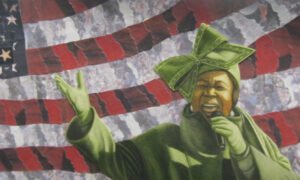 Now I’ve a funny relationship to the art of Bryan Collier. Sometimes I feel like he gives a book his all and comes out swinging as a result. If you’ve ever seen his work on Uptown or Knock Knock or Martin’s Big Words or Dave the Potter then you know what he’s capable of. By the same token, for every Uptown there’s a Lincoln and Douglass where it just doesn’t have that good old-fashioned Collier magic. I worried that maybe My Country, ‘Tis of Thee would fall into that category, particularly after seeing the anemic George Washington awkwardly placed on the book’s cover. As it turns out, that’s probably the weakest image in the book. Go into it and you’ll see that Collier is in fine fettle for the most part. For example, in a section discussing how both the North and the South adopted this song and sang their own verses to it, Collier brilliantly overlays a soldier’s tent against a plantation background. Inside the tent are shots of the battle raging, letters from the soldiers spilling out over the sides like a fabric of their own. Turn the page and now the fields are bare, the Emancipation Proclamation having been declared, and the papers you see floating across the earth and into the sky all begin with “A Proclamation”. This is the kind of attention to detail that gets completely ignored in a work of nonfiction, even when the artist has taken a great deal of care and attention. It took me about five or six reads before I would notice the photographs of kids interspersed with the drawn people. And sure there’s the occasional misstep (the tea dumped by the Bostonians looks a bit more like the wings of birds than something you’d like to consume, and while Collier nails Aretha Franklin better than anyone I’ve ever seen he just can NOT get George Washington quite right) on the whole the book hangs together as well as it does because Collier knows what he’s doing.
Now I’ve a funny relationship to the art of Bryan Collier. Sometimes I feel like he gives a book his all and comes out swinging as a result. If you’ve ever seen his work on Uptown or Knock Knock or Martin’s Big Words or Dave the Potter then you know what he’s capable of. By the same token, for every Uptown there’s a Lincoln and Douglass where it just doesn’t have that good old-fashioned Collier magic. I worried that maybe My Country, ‘Tis of Thee would fall into that category, particularly after seeing the anemic George Washington awkwardly placed on the book’s cover. As it turns out, that’s probably the weakest image in the book. Go into it and you’ll see that Collier is in fine fettle for the most part. For example, in a section discussing how both the North and the South adopted this song and sang their own verses to it, Collier brilliantly overlays a soldier’s tent against a plantation background. Inside the tent are shots of the battle raging, letters from the soldiers spilling out over the sides like a fabric of their own. Turn the page and now the fields are bare, the Emancipation Proclamation having been declared, and the papers you see floating across the earth and into the sky all begin with “A Proclamation”. This is the kind of attention to detail that gets completely ignored in a work of nonfiction, even when the artist has taken a great deal of care and attention. It took me about five or six reads before I would notice the photographs of kids interspersed with the drawn people. And sure there’s the occasional misstep (the tea dumped by the Bostonians looks a bit more like the wings of birds than something you’d like to consume, and while Collier nails Aretha Franklin better than anyone I’ve ever seen he just can NOT get George Washington quite right) on the whole the book hangs together as well as it does because Collier knows what he’s doing.
I can already tell you that this book will not get the attention it deserves. And what it deserves is a place in every single classroom, library, and bookstore shelf in the nation. Yet this isn’t a work of children’s nonfiction that slots neatly into a pre-made hole. There’s nothing else really like this book out there. That it works as a brilliant piece of nonfiction as well as a smart as all get out piece of history and classroom ideas for teachers is clear. What it has to say about our country and our people and how they’ve fought for their rights should not, under any circumstances, be missed. It’s hard to write patriotic American fare for kids that doesn’t just sound like boosterism. This book manages to pull it off and you feel pretty good after it does. Do not miss it. Don’t.
On shelves June 3rd.
Source: Galley sent from publisher for review.
Like This? Then Try:
- We Shall Overcome: The Story of a Song by Debby Levy – More of a picture book like this one and nowhere near as well researched, but fun and a good companion in the old history-of-a-song-in-America genre.
Professional Reviews:
Interviews:
- Bryan Collier talks about his work and discusses this book a little bit as well with SLJ.
Misc:
- How cool is this? Murphy has linked to a My Country Tis of Thee Music Project where “Choirs of all ages and abilities are invited to participate in the Music Project by singing and recording their own versions of My Country, Tis of Thee at school and in their communities.” Want to know more? Go here and then listen to some of the choirs that are already up for your listening pleasure.
- Murphy answers a couple questions about the book here.


By:
Betsy Bird,
on 4/8/2014
Blog:
A Fuse #8 Production
(
Login to Add to MyJacketFlap)
JacketFlap tags:
Best Books of 2014,
Reviews 2014,
2014 reviews,
2014 biographies,
2014 nonfiction,
2015 Sibert contender,
2015 Caldecott contender,
Arun Gandhi,
Evan Turk,
Reviews,
nonfiction,
nonfiction picture books,
biographies,
Simon and Schuster,
Atheneum,
Best Books,
picture book biographies,
Bethany Hegedus,
Add a tag
 Grandfather Gandhi
Grandfather Gandhi
Arun Gandhi and Bethany Hegedus
Illustrated by Evan Turk
Atheneum (an imprint of Simon and Schuster)
$17.99
ISBN: 978-1-4424-2365-X
Ages 4-8
On shelves now.
Are you familiar with the concept of booktalking? It’s a technique librarians developed to get people interested in books they might otherwise not pick up. The whole concept is to develop a kind of movie trailer style talk that gives a sense of the book’s allure without giving up the plot. Typically booktalking is done for middle grade and young adult works of fiction, but enterprising souls have had a lot of luck with nonfiction as well. Now with an increased interest in nonfiction in our schools it’s more important than ever to make the books we hawk sound particularly good. It doesn’t hurt matters any when the books actually ARE good, though. Now let’s say I’m standing in front of a room of second and third graders with a copy of Grandfather Gandhi in my hands. How do I sell this book to them? Easy peasy. Some books practically booktalk themselves. Here’s how you sell it:
“Have any of you ever heard of Einstein? Yes? He’s the guy that was a total genius. Now imagine you’re his grandkid and you’re not that smart. Okay now, have any of you heard of the Beatles. Yes? Well imagine you’re one of THEIR grandkids . . . and you’re bad at music. Now here’s the big one. Has anyone heard of Gandhi? He was a great guy. He managed to free his country and stop a lot of oppression and he did it without any violence at all. Martin Luther King Jr. got some of his ideas from Gandhi about nonviolence. All right, well, now let’s image you are Gandhi, the most peaceful man IN THE WORLD’s grandson. What if you get mad? Can you imagine what it would be like to have everyone whispering every time you got a little steamed about something?”
So there you go. Quick. Simple. To the point. I’ve met a fair number of picture book memoirs in my day, but Grandfather Gandhi may well be my favorite. Smartly written with an unusual hook and art that will just knock your socks off, this is one title you are going to have to see firsthand for yourself.
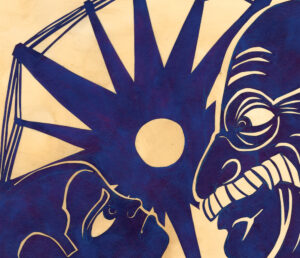 When young Arun and his family first arrive in his grandfather Mahatma Gandhi’s village, he’s mighty shy around his incredibly famous relative. Yet right away Grandfather is warm and welcoming to them, and when he praises Arun for walking the distance from the train station the boy swells with pride. Unfortunately, having Gandhi as your grandpa means having to share him with the 350 followers who also live in the village. Arun struggles with his lessons in Gujarati and the fact that there are no movie theaters around, but there are upsides to village life too. He’s pretty good at soccer with the other kids, and occasionally Grandfather will take him for a walk just mano a mano. But then, one fateful day, Arun gets into a skirmish on the soccer field and his anger is overwhelming. Shamed that the grandson of Gandhi himself would react in anger he confesses to his Grandfather immediately, only to find the man isn’t angry or disappointed in him in the least. Anger, Gandhi explains, is like lightning. You can use it to destroy or you can use it to light the world, like a lamp. Which will you choose?
When young Arun and his family first arrive in his grandfather Mahatma Gandhi’s village, he’s mighty shy around his incredibly famous relative. Yet right away Grandfather is warm and welcoming to them, and when he praises Arun for walking the distance from the train station the boy swells with pride. Unfortunately, having Gandhi as your grandpa means having to share him with the 350 followers who also live in the village. Arun struggles with his lessons in Gujarati and the fact that there are no movie theaters around, but there are upsides to village life too. He’s pretty good at soccer with the other kids, and occasionally Grandfather will take him for a walk just mano a mano. But then, one fateful day, Arun gets into a skirmish on the soccer field and his anger is overwhelming. Shamed that the grandson of Gandhi himself would react in anger he confesses to his Grandfather immediately, only to find the man isn’t angry or disappointed in him in the least. Anger, Gandhi explains, is like lightning. You can use it to destroy or you can use it to light the world, like a lamp. Which will you choose?
I think it’s fair to say that there have been a fair number of children’s picture books from family and relatives of famous peacemakers. Most notable would be Martin Luther King Jr.’s clan, where it sometimes seems like every son, daughter, niece, and nephew has his or her own spin on their infinitely famous relative. Gandhi’s a bit different. One wouldn’t expect his own descendants to have much in the way of access to the American publishing industry, so biographies of his life in picture book form have concentrated occasionally on his life and occasionally on The Great Salt March. When I saw that this book was co-authored by his fifth grandson I expected the same sort of story. A kind of mix of “this guy was fantastic” with “and I knew him!”. Instead, Hegedus and Gandhi have formulated a much more accessible narrative. Few children can relate to having a famous relative. But what about controlling their anger in the face of injustice? What’s fascinating about this book is that the authors have taken a seemingly complex historical issue and put it into terms so child-friendly that a five-year-old could get the gist of it. That Gandhi’s anger went on to become what spurned him to make lasting, important changes for his people is the key point of the book, but it takes a child’s p.o.v. to drill the issue home.
 Above and beyond all that, this is a book that advocates quite strongly for peace in all its myriad forms. Hardly surprising when you consider the subject matter but just the same I sometimes feel like “peace” is one of those difficult concepts without a proper picture book advocate. I went to a Quaker college where PAGS (Peace and Global Studies) was a popular major, and it was in making Quaker friends that I learned about picture books dedicated to the concepts embraced by that particular religion. Books like The Story of Ferdinand by Munro Leaf, The Table Where Rich People Sit by Byrd Baylor, Thy Friend, Obadiah by Brinton Turkle, and more. I’m sure that many is the Quaker household, or really any household that believes that peace is a practical and attainable solution, that will embrace Grandfather Gandhi as one of their own.
Above and beyond all that, this is a book that advocates quite strongly for peace in all its myriad forms. Hardly surprising when you consider the subject matter but just the same I sometimes feel like “peace” is one of those difficult concepts without a proper picture book advocate. I went to a Quaker college where PAGS (Peace and Global Studies) was a popular major, and it was in making Quaker friends that I learned about picture books dedicated to the concepts embraced by that particular religion. Books like The Story of Ferdinand by Munro Leaf, The Table Where Rich People Sit by Byrd Baylor, Thy Friend, Obadiah by Brinton Turkle, and more. I’m sure that many is the Quaker household, or really any household that believes that peace is a practical and attainable solution, that will embrace Grandfather Gandhi as one of their own.
It’s been a long time since I ran across a picture book with as long and lengthy a list of materials used in the illustrations as I have here. On the publication page it reads, “The illustrations for this book are rendered in watercolor, paper collage, cotton fabric, cotton, yarn, gouache, pencil, tea, and tin foil. Cotton hand spun on an Indian book charkha by Eileen Hallman.” Phew! You might think that all that “stuff” might yield something clogged up or messy, but that would be doing Mr. Turk a disservice. Observing how well he gives his pictures depth and texture, life and vitality, you might be shocked to learn that Grandfather Gandhi is his first picture book. From the spinning wheel endpapers to montages of sheer explosive anger, Turk makes a point of not only adhering to some of the more metaphorical aspects of the text, but finding new and creative ways to bring them to visual life. To my mind, the materials an artist uses in his or her art must, in the case of mixed media, have a reason for their existence. If you’re going to use “cotton fabric, cotton” and “yarn” then there should be a reason. But Turk clearly did his homework prior to doing the art on this book. He doesn’t just slap the images together. He incorporates the fibers Gandhi knew so well and turns them into an essential aspect of the book’s art. The art doesn’t just support the text here. It weaves itself into the story, becoming impossible to separate from the story.
 It’s Arun’s anger that proved to be the most visually interesting aspect, to me, in the book. Turk deftly contrasts the calm white thread produced by Gandhi’s spinning with the tangled black ones that surround and engulf his grandson whenever his feelings threaten to break free. The scene where he’s tempted to throw a rock at the boy who shoved him down is filled with thread, Arun’s magnificently clenched teeth, and black shadow figures that reach out across the field to the soccer net, dwarfing the three other little figures below. Later you can see the negative space found in cut paper turning from a representation of lightning into a thread of cotton in the hands of Gandhi illuminating a passage about making your anger useful. Yet Turk doesn’t just rely on clever techniques. He’s remarkably skilled at faces too. Arun’s expressions when he gets to see his grandfather alone or makes him proud are just filled with wide-eyed eager hope. And his frustrations and anger pulse off the page from his features alone.
It’s Arun’s anger that proved to be the most visually interesting aspect, to me, in the book. Turk deftly contrasts the calm white thread produced by Gandhi’s spinning with the tangled black ones that surround and engulf his grandson whenever his feelings threaten to break free. The scene where he’s tempted to throw a rock at the boy who shoved him down is filled with thread, Arun’s magnificently clenched teeth, and black shadow figures that reach out across the field to the soccer net, dwarfing the three other little figures below. Later you can see the negative space found in cut paper turning from a representation of lightning into a thread of cotton in the hands of Gandhi illuminating a passage about making your anger useful. Yet Turk doesn’t just rely on clever techniques. He’s remarkably skilled at faces too. Arun’s expressions when he gets to see his grandfather alone or makes him proud are just filled with wide-eyed eager hope. And his frustrations and anger pulse off the page from his features alone.
Picture books for kids about dealing with their anger tend towards the fictional. There’s Molly Bang’s When Sophie Gets Angry . . . Really Really Angry and Robie H. Harris’s The Day Leo Said, “I Hate You”. These are two of the good ones. Others veer towards the preachy and paternalistic. Imagine if you started using something like Grandfather Gandhi instead. More than just a memoir, the book offers a broad look at the benefits of channeling your anger. Better still, it’s a true story. Kids respect the true. They’ll also respect young Arun and his uncomfortable position. Fair play to author Bethany Hegedus for hearing him speak more than 13 years ago about this moment in his life, knowing that not only was there a picture book story to be had here, but a lesson kids today can grasp. As she says in her “Note from the Authors” at the end, “We world we live in needs to heal – to heal from the wars that are fought, to the bullying epidemic, to mass killings by lone gunmen, to poverty, to hunger, and to issues that contribute to internal anger being outwardly expressed in violent actions.” Gandhi’s message never grows old. Now we’ve a book that helps to continue his work for the youngest of readers. A necessary purchase then.
On shelves now.
Source: Final copy sent from publisher for review.
Like This? Then Try:
Other Blog Reviews:
Professional Reviews:
Interviews:
- ReaderKidZ speaks with Ms. Hegedus about the book.
- Meanwhile Kirkus interviewed the two authors and the illustrator here.
Misc: This is a book with a very nicely maintained and updated website of its own. Some of my favorite posts include this one from Evan Turk on how he got access to the spun cotton fiber featured in the book. I also light his piece on Light & Shadow and this one on how he chose his art. Arun even has posts up containing family Gandhi stories that would make an excellent follow up books should the need arise. Be sure to read the one on pumpkins and eggs when you get a chance.
Video:
One of the top best book trailers I’ve seen in a really long time. Accomplished and it does a brilliant job of highlighting Turk’s art.
llustration & Animation by Evan Turk
Voices: Arun Gandhi & Bethany Hegedus

 Rotten Pumpkin
Rotten Pumpkin
By David M. Schwartz
Photos by Dwight Kuhn
Creston Books
$16.99
ISNB: 978-1-939547-03-3
Ages 4-8
On shelves now.
Every October you walk into your bookstores and your libraries and you see the overwhelming swath of seasonal fare pelt you from every side. Apples and pumpkins, scarecrows and black cats. You begin to wonder if it’s possible to do anything that’s both new and autumnal anymore. Then you turn around and you see the book most likely to make you back away in true, abject fear. Rotten Pumpkin: A Rotten Tale in 15 Voices is basically what you’d get if you took Paul Fleischman’s Joyful Noise: Poems for Two Voices or Laura Amy Schlitz’s Good Masters! Sweet Ladies!: Voices from a Medieval Village and turned those bugs and people into molds, slugs, and other creepy crawlies. I have never been so overwhelmed with a desire to wash my hands after reading a book as I have reading Schwartz’s latest. That’s a compliment, by the way.
It doesn’t start off all that badly. On Halloween night a triumphant little pumpkin merrily grins at the reader. “Here I stand, bright with light, proud and round. Tonight is my glory night. Call me Jack.” Its hubris doesn’t last long. The first unwelcome visitor is a chomping chewing mouse. The next a squirrel. Then come the slugs, a fly, and most dramatically the black rot. Once the rot’s set in it’s just a question of how quickly Jack will disintegrate. Schwartz fills his story with plenty of useful information, like the fact that low temperatures don’t slow most of the fungi that eat pumpkins. Or the strange nature of the plasmodium and its odd ways. By the end we see how life begins anew, thanks in large part to the creatures that help with decomposition. A glossary of terms and useful “Classroom Investigations” are found at the end of the book.
 When we think of books told in a variety of different voices, our minds instantly think of some of the loftier titles for kids out there. Award winners. Collections of monologues. That sort of thing. So I think it would be particularly refreshing for kids to embody the characters in this book. I’m suddenly envisioning the world’s grossest school play, wherein our hero, the pumpkin, is eaten and devoured by his/her classmates, piece by piece. The characters, if you can call them that, aren’t delineated in the text by anything more than their images. Sections run together without chapter titles. I was also a bit sad that the photos were separate from the text, when it would have been nice to see the two integrated. That said, I did like the writing. It does a good job of telling a story, conveying some really interesting factual information, and grossing you out. Surprisingly, this is the book that actually explained Penicillium to me better than anything else I’ve ever read. Not being much of a scientist I confess that I’d always been a bit fuzzy (no pun intended) on what precisely it is that Penicillium does. I know the story of how it was discovered, but not why it works. Now I do.
When we think of books told in a variety of different voices, our minds instantly think of some of the loftier titles for kids out there. Award winners. Collections of monologues. That sort of thing. So I think it would be particularly refreshing for kids to embody the characters in this book. I’m suddenly envisioning the world’s grossest school play, wherein our hero, the pumpkin, is eaten and devoured by his/her classmates, piece by piece. The characters, if you can call them that, aren’t delineated in the text by anything more than their images. Sections run together without chapter titles. I was also a bit sad that the photos were separate from the text, when it would have been nice to see the two integrated. That said, I did like the writing. It does a good job of telling a story, conveying some really interesting factual information, and grossing you out. Surprisingly, this is the book that actually explained Penicillium to me better than anything else I’ve ever read. Not being much of a scientist I confess that I’d always been a bit fuzzy (no pun intended) on what precisely it is that Penicillium does. I know the story of how it was discovered, but not why it works. Now I do.
 It’s hard for me to pinpoint what the most disgusting moment of this book really is. Was it the title page with its leering jack-o-lantern leering, bedecked with a black mustache of pure mold? Was it instead the yeast swimming in the fermenting pumpkin, an almost peach colored jelly packed with white rods? No. For me, without a doubt, the honor lies squarely on the spores. We have photographer Dwight Kuhn to thank for that. Having worked on “more than 140 children’s books on nature and biology”, Kuhn had his work cut out for him when it came to some of the shots in this book. The squirrel was keen, the mouse divine, and the slugs sluggy, but the shot that impressed me the most was the extreme close-up of the fly. *shudder* You’d have to see it for yourself to understand why.
It’s hard for me to pinpoint what the most disgusting moment of this book really is. Was it the title page with its leering jack-o-lantern leering, bedecked with a black mustache of pure mold? Was it instead the yeast swimming in the fermenting pumpkin, an almost peach colored jelly packed with white rods? No. For me, without a doubt, the honor lies squarely on the spores. We have photographer Dwight Kuhn to thank for that. Having worked on “more than 140 children’s books on nature and biology”, Kuhn had his work cut out for him when it came to some of the shots in this book. The squirrel was keen, the mouse divine, and the slugs sluggy, but the shot that impressed me the most was the extreme close-up of the fly. *shudder* You’d have to see it for yourself to understand why.
Who says the scariest Halloween books for kids are strictly fictional? With Rotten Pumpkin you’ve all the thrills of a typical horror story, laden with facts along the way. The hero at the top of his game. The downfall. The insidious, frankly disgusting, forces that eat away at him until he’s nothing left but a blackened husk of his former self. Oh, it’s thrilling stuff. With applications in the classroom, in the home, and on the stage, there’s nowhere this rotting corpse of a pumpkin doesn’t belong. So this holiday season don’t bother handing the kids yet another copy of Scary Stories to Tell In the Dark when they beg you for child-friendly horror fare. Just load them down with a little Rotten Pumpkin. Guaranteed to make hypochondriacs out of even the stiffest souls.
On shelves now.
Source: Final copy sent from publisher for review.
Like This? Then Try:
Other Blog Reviews:
Professional Reviews:
Interview: David M. Schwartz answers his own questions about the book.






By:
Administrator,
on 2/20/2013
Blog:
Margo Dill's Read These Books and Use Them!
(
Login to Add to MyJacketFlap)
JacketFlap tags:
nonfiction picture books,
Elementary Educators,
Making Personal Connections,
Research Ideas,
Books With Social Studies Content,
Writing Skills,
Presidents' Day,
picture books about the president,
Gherman Beverly,
Picture Book,
Add a tag

*Nonfiction picture book about the U.S. presidents’ mothers for upper elementary
*Mothers as main topics in the book
*Rating: I adore this book, First Mothers written by Beverly Gherman. The language is perfect for kids–she took a difficult subject & did a wonderful job with it! The illustrations by Julie Downing are even better–there’s even some humor, which makes a book like this more appealing to kids!
Short, short summary:
First Mothers is a look at every single president’s mother from George Washington to Barack Obama. The author tells vital statistics such as birth, death, marriage date, and date she gave birth to the president. Each mother is also given a title, such as George Washington’s mother, which is The FIRST First Mother, Ida Stover Eisenhower, which is The Pacifist Mother, and Barbara Pierce Bush, The Outspoken Mother. There are also paragraphs about each mother with details about what she liked to do, how she raised her children, how she met the president’s father, and more. For example, on the page about President Grant’s mother, Hannah Simpson Grant, the author tells how she was shy and didn’t even attend her son’s presidential inauguration or brag about him when he went to West Point or became the general of the Union Army. The illustration of her shows a woman sewing and a speech bubble that says, “It’s not right to brag, but Ulysses was a good boy.” Children and adults will get a kick out of this book. I found it fascinating!
So, what do I do with this book?
1. Have each student choose a First Mother to research further OR research a bit about her son, and see if there’s any connection to the son’s interests/way he was president and her description in the book. Since these research projects could be enormous, ask students to focus on certain aspects, such as: Did the mother have a job outside the home? What were her hobbies? What did her other children do? Where did she live her life?
2. The illustrations in this book (by Julie Downing) are fantastic! I really recommend going through the book and just looking and studying the illustrations. Towards the end, some of the first mothers reappear and make comments–on Barack Obama’s mom’s page, the first mothers from the 18th and 20th century say, “Is she wearing pants?” HA! On Bill Clinton’s mom’s page, the older first mothers ask, “What did she do to her hair?” Bill Clinton’s mom had a white streak through it, kind of like a skunk. . .Sometimes, as teachers/parents, we don’t take the time to look at illustrations. You don’t want to do that with this book.
3. The very last page of this book has a first mother standing there with a speech bubble, which says: “So, if you want to be president, listen to your mother.” Use this as a writing prompt with students. Ask them to think of advice they’ve heard from a female role model that could help them to one day be president. An example would be, “Mind your manners.” “Do your homework before you play.” “Read every day.”
Don’t forget, I have an exciting giveaway going on! It’s for a middle-grade (8 to 12) Christian fiction novel titled, A Cat Named Mouse: The Miracle of Answered Prayer. Go here to enter the giveaway.

By:
Betsy Bird,
on 1/20/2013
Blog:
A Fuse #8 Production
(
Login to Add to MyJacketFlap)
JacketFlap tags:
Reviews,
biography,
math,
nonfiction picture books,
Roaring Brook,
Best Books,
picture book biographies,
LeUyen Pham,
macmillan,
Deborah Heiligman,
math picture books,
Best Books of 2013,
Reviews 2013,
2013 biography,
2013 nonfiction,
2013 picture book biography,
2014 Caldecott Contender,
2014 Sibert Award contender,
Add a tag
 The Boy Who Loved Math: The Improbable Life of Paul Erdős
The Boy Who Loved Math: The Improbable Life of Paul Erdős
By Deborah Heiligman
Illustrated by LeUyen Pham
Roaring Brook (an imprint of Macmillan)
ISBN: 978-1-59643-307-6
Ages 6 and up
On shelves June 25th
Make a beeline for your local library’s children’s biography section and learn firsthand the shocking truth about picture book bios of mathematical geniuses. Apparently there was only one and his name was Einstein. End of story. The world as we know it is not overflowing with picture book encapsulations of the lives of Sir Isaac Newton or Archimedes (though admittedly you could probably drum up a Leonardo da Vinci book or two if you were keen to try). But when it comes to folks alive in the 20th century, Einstein is the beginning and the end of the story. You might be so foolish as to think there was a good reason for that fact. Maybe all the other mathematicians were dull. I mean, Einstein was a pretty interesting fella, what with his world-shattering theories and crazed mane. And true, the wild-haired physicist was fascinating in his own right, but if we’re talking out-and-out interesting people, few can compare with the patron saint of contemporary mathematics, Paul Erdős. Prior to reading this book I would have doubted a person could conceivably make an engaging biography chock full to overflowing with mathematical concepts. Now I can only stare in amazement at a story that could conceivably make a kid wonder about how neat everything from Euler’s map of Konigsburg to the Szekeres Snark is. This is one bio you do NOT want to miss. A stunner from start to finish.
For you see, there once was a boy who loved math. His name was Paul and he lived in Budapest, Hungary in 1913. As a child, Paul adored numbers, and theorems, and patterns, and tricky ideas like prime numbers. As he got older he grew to be the kind of guy who wanted to do math all the time! Paul was a great guy and a genius and folks loved having him over, but he was utterly incapable of taking care of himself. Fortunately, he didn’t have to. Folks would take care of Paul and in exchange he would bring mathematicians together. The result of these meetings was great strides in number theory, combinatorics, the probabilistic method, set theory, and more! Until the end of this days (when he died in a math meeting) Paul loved what he did and he loved the people he worked with. “Numbers and people were his best friends. Paul Erdős had no problem with that.”
There are two kinds of picture book biographies in this world. The first attempts to select just a single moment or personality quirk from a person’s life, letting it stand in as an example of the whole. Good examples of this kind of book might include Me…Jane by Patrick McDonnell about the childhood of Jane Goodall or Lincoln Tells a Joke: How Laughter Saved the President And the Country by Kathleen Krull. It’s hard to pinpoint the perfect way to convey any subject, but it can sometimes be even harder to tell an entire life in the span of a mere 40 pages or so. Still, that tends to be the second and more common kind of picture book biography out there. Generally speaking they don’t tend to be terribly interesting. Just a series of rote facts, incapable of making it clear to a kind why a person mattered aside from the standard “because I said so” defense. The Boy Who Loved Math is different because it really takes the nature of biography seriously. If the purpose of a bio is to make it clear that a person was important, how important was a guy who loved math puzzles? Well, consider what the story can do. In a scant number of pages author Deborah Heiligman gives us an entire life synthesized down to just a couple key moments, giving the man’s life form and function and purpose, all while remaining lighthearted and fun to read. Who does that?
Did you know that there are kids out there who like math? I mean, reeeeeeally like math? The kinds that beg their parents for math problems to solve? They exist (heck, Ms. Heiligman gave birth to one) and for those kids this book will come like a present from on high. Because not only does the author highlight a fellow who took his passion for numbers and turned it into a fulfilling and fun life, but thanks to illustrator LeUyen Pham the illustrations are overflowing with math equations and puzzles and problems, just waiting to be interpreted and dissected. I have followed the career of Ms. Pham for many years. There is no book that she touches that she does not improve with her unique style. Whether it’s zeroing in on a child’s neuroses in Alvin Ho or bringing lush life to a work of poetry as in A Stick Is an Excellent Thing, Pham’s art can run the gamut from perfect interstitial pen-and-inks to lush watercolor paints. I say that, but I have never, but ever, seen anything like what she’s done in The Boy Who Loved Math.
It would not be overstating the matter to call this book Pham’s masterpiece. The common story behind its creation is that there was some difficulty finding the perfect artist for it because whosoever put pen to paper here would have to be comfortable on some level with incorporating math into the art. Many is the artist who would shy away from that demand. Not Ms. Pham. She takes to the medium like a duck to water, seemingly effortlessly weaving equations, charts, diagrams, numbers, and theorems into pictures that also have to complement the story, feature the faces of real people, capture a sense of time (often through clothing) and place (often through architecture), and hardest of all, be fun to look at.
But that’s just for starters. The final product is MUCH more complex. I’m not entirely certain what the medium is at work here but if I had to guess I’d go with watercolors. Whatever it is, Pham’s design on each page layout is extraordinary. Sometimes she’ll do a full page, border to border, chock full of illustrations of a single moment. That might pair with a page of interstitial scenes, giving a feel to Paul’s life. Or consider the page where you see a group of diners at a restaurant, their worlds carefully separated into dotted squares (a hat tip to one of Paul’s puzzles) while Paul sits in his very own dotted pentagon. It’s these little touches that make it clear that Paul isn’t like other folks. All this culminates in Pham’s remarkable Erdős number graph, where she outdoes herself showing how Paul intersected with the great mathematicians of the day. Absolutely stunning.
Both Heiligman and Pham take a great deal of care to tell this tale as honestly as possible. The extensive “Note From the Author” and “Note From the Illustrator” sections in the back are an eye-opening glimpse into what it takes to present a person honestly to a child audience. In Pham’s notes she concedes when she had to illustrate without a guide at hand. For example, Paul’s babysitter (“the dreaded Faulein”) had to be conjured from scratch. She is the rare exception, however. Almost every face in this book is a real person, and it’s remarkable to look and see Pham’s page by page notes on who each one is.
Heiligman’s author’s note speaks less to what she included and more to what she had to leave out. She doesn’t mention the fact that Paul was addicted to amphetamines and honestly that sort of detail wouldn’t have served the story much at all. Similarly I had no problem with Paul’s father’s absence. Heiligman mentions in her note what the man went through and why his absences would make Paul’s mother the “central person in his life emotionally”. The book never denies his existence, it just focuses on Paul’s mother as a guiding force that was perhaps in some way responsible for the man’s more quirky qualities. The only part of the book that I would have changed wasn’t what Heiligman left out but what she put in. At one point the story is in the midst of telling some of Paul’s more peculiar acts as a guest (stabbing tomato juice cartons with knives, waking friends up at 4 a.m. to talk math, etc.). Then, out of the blue, we see a very brief mention of Paul getting caught by the police when he tried to look at a radio tower. That section is almost immediately forgotten when the text jumps back to Paul and his hosts, asking why they put up with his oddities. I can see why placing Paul in the midst of the Red Scare puts the tale into context, but I might argue that there’s no real reason to include it. Though the Note for the Author at the end mentions that because of this act he wasn’t allowed back in the States for a decade, it doesn’t have a real bearing on the thrust of the book. As they say in the biz, it comes right out.
I have mentioned that this book is a boon for the math-lovers of the world, but what about the kids who couldn’t care diddly over squat about mathy malarkey? Well, as far as I’m concerned the whole reason this book works is because it’s fun. A little bit silly too, come to that. Even if a kid couldn’t care less about prime numbers, there’s interest to be had in watching someone else get excited about them. We don’t read biographies of people exactly like ourselves all the time, because what would be the point of that? Part of the reason biographies even exist is to grant us glimpses into the lives of the folks we would otherwise never have the chance to meet. Your kid may never become a mathematician, but with the book they can at least hang out with one.
One problem teachers have when they teach math is that they cannot come up with a way to make it clear that for some people mathematics is a game. A wonderful game full of surprises and puzzles and queries. What The Boy Who Loved Math does so well is to not only show how much fun math can be on your own, it makes it clear that the contribution Paul Erdős gave to the world above and beyond his own genius was that he encouraged people to work together to solve their problems. Heiligman’s biography isn’t simply the rote facts about a man’s life. It places that life in context, gives meaning to what he did, and makes it clear that above and beyond his eccentricities (which admittedly make for wonderful picture book bio fare) this was a guy who made the world a better place through mathematics. What’s more, he lived his life exactly the way he wanted to. How many of us can say as much? So applause for Heiligman and Pham for not only presenting a little known life for all the world to see, but for giving that life such a magnificent package as this book. A must purchase.
On shelves June 25th
Source: Advanced readers galley sent from publisher for review.
Like This? Then Try:
Misc:







By:
Betsy Bird,
on 12/28/2012
Blog:
A Fuse #8 Production
(
Login to Add to MyJacketFlap)
JacketFlap tags:
nonfiction picture books,
Best Books,
picture book biographies,
Houghton Mifflin Harcourt,
Clarion Books,
multicultural picture books,
Gary Golio,
Rudy Gutierrez,
Best Books of 2012,
2012 picture book biographies,
African-American biographies,
African-American picture book biographies,
2012 nonfiction picture books,
Reviews,
Add a tag
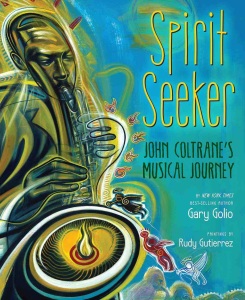 Spirit Seeker: John Coltrane’s Musical Journey
Spirit Seeker: John Coltrane’s Musical Journey
By Gary Golio
Illustrated by Rudy Gutierrez
Clarion Books (an imprint of Houghton Mifflin Harcourt)
$17.99
ISBN: 978-0-547-23994-1
Ages 6 and up
On shelves now
Is there any complicated hero with a past so full of darkness that their life cannot be recounted to children? This is the conundrum of any author who takes it upon his or herself to tell the stories of people who didn’t grow up happy, live lightly, and die laughing in their beds. The most interesting stories are sometimes the ones about folks who look into the eye of the devil and walk away the wiser. Trouble is, it can be hard to figure out whether or not theirs is a story kids need to know. They might love the life of Charlie Chaplin, but do you bring up his penchant for the very young ladies? Bob Marley did great things in his life . . . and consumed great amounts of drugs. Do you talk to kids about him? In the end, it all comes down to the skill of the biographer. The person who sits down and turns a great man or woman into a 32-48 page subject, appropriate for kids too young to watch PG-13 films on their own. To do it adequately is admirable. To do it brilliantly, as it’s done in Spirit Seeker: John Coltrane’s Musical Journey is worthy of higher praise.
He led as perfect a childhood as any African-American kid in the late 1930s could hope for. A loving family, two grandfather preachers, a great musician for a dad, the works. But all that came before the deaths. First his grandfather, then his father, then his grandmother too. Things grew dark for John, but an opportunity to learn the saxophone for free arose. It became John’s new religion, and the void inside him was easily filled by drugs and alcohol. He was brilliant at the instrument but was his own worst enemy when his addictions held sway. Golio tells the tale of how one young man bucked his fate and went on to become a leader in more ways than one. An Afterward, Author’s Note, Artist’s Note, and Sources and Resources appear at the end.
 In any picture book biography (and this applies to bio pics on the silver screen too) the author needs to determine whether or not they’re going to try to cover the wide swath of their subject’s life, or if they’re going to select a single incident or turning point in that life and use that as the basis of their interpretation. Golio almost has it both ways. He’s certainly more in the wide swath camp, his book extending from John the child to John the successful and happy (relatively) adult. But within that storyline Golio takes care to build on certain images and themes. Reading through it you come to understand that he is showing how a happy child can become a brilliant but cursed young man, and then can escape his own personal demons, inspiring others even as he inspires himself. Under Golio’s hand Coltrane’s early exposure to religion reverberates every time he seeks out more spiritual knowledge, regardless of the sect. He loses so many people he loves (to say nothing of financial stability) then grows up to become the perfect melding of both his grandfather and his father.
In any picture book biography (and this applies to bio pics on the silver screen too) the author needs to determine whether or not they’re going to try to cover the wide swath of their subject’s life, or if they’re going to select a single incident or turning point in that life and use that as the basis of their interpretation. Golio almost has it both ways. He’s certainly more in the wide swath camp, his book extending from John the child to John the successful and happy (relatively) adult. But within that storyline Golio takes care to build on certain images and themes. Reading through it you come to understand that he is showing how a happy child can become a brilliant but cursed young man, and then can escape his own personal demons, inspiring others even as he inspires himself. Under Golio’s hand Coltrane’s early exposure to religion reverberates every time he seeks out more spiritual knowledge, regardless of the sect. He loses so many people he loves (to say nothing of financial stability) then grows up to become the perfect melding of both his grandfather and his father.
Just as Golio builds on repeating images and themes in his text, so too does artist Rudy Gutierrez make a go of it in his art. The author/artist pairing on picture book is so often a case of an author writing a story, handing it over to their editor, that editor assigning it to an illustrator, and the illustrator working on the piece without any interaction with its original creator. It seems like a kind of crazy way to make great picture books, and many times the art and the text won’t meld as beautifully as they could. Then you’ll see a book like Spirit Seeker and though I know that “Gary Golio” is not a pseudonym for “Rudy Gutierrez” (or vice-versa) it sure feels like the two slaved together over each double-paged spread. I suppose the bulk of that credit lies with Gutierrez, all fairness to Golio’s text admitted. Gutierrez explains in his Artist’s Note at the end of the book that Coltrane was such an “artistic angel” to him that he fasted for two weeks so as to best focus, meditate, pray and paint this book. The result is a product that looks as though someone cared and cared deeply about the subject matter.
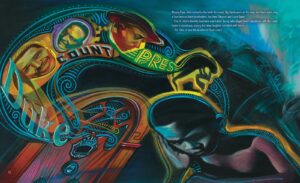 Mind you, the book will do kids and adults little good unless they like Gutierrez’s style. I happen to find it remarkable. He strikes the perfect balance between the literal and allegorical representation of certain aspects of Coltrane’s life. Some artists fall too far on one side or the other of that equation. Gutierrez isn’t afraid to attempt both at once. You’ve the energy of his lines trying to replicate the energy of the music, John’s grandfather’s preaching, his spiritual journey, etc. There are moments when you can actually sit a kid down and ask them something like, “What do you think it means when that single curving line moves from John’s father’s violin to his son’s heart?” At the same time, you know that Gutierrez is doing a stand up and cheer job of replicating the faces of the real people in this book time and time again. The melding of the two, sad to say, does turn a certain type of reader off. Fortunately I think that a close rereading can allay most fears.
Mind you, the book will do kids and adults little good unless they like Gutierrez’s style. I happen to find it remarkable. He strikes the perfect balance between the literal and allegorical representation of certain aspects of Coltrane’s life. Some artists fall too far on one side or the other of that equation. Gutierrez isn’t afraid to attempt both at once. You’ve the energy of his lines trying to replicate the energy of the music, John’s grandfather’s preaching, his spiritual journey, etc. There are moments when you can actually sit a kid down and ask them something like, “What do you think it means when that single curving line moves from John’s father’s violin to his son’s heart?” At the same time, you know that Gutierrez is doing a stand up and cheer job of replicating the faces of the real people in this book time and time again. The melding of the two, sad to say, does turn a certain type of reader off. Fortunately I think that a close rereading can allay most fears.
In my own case, it took several rereadings before I began to pick up on Gutierrez’s repeated tropes. Golio begins the book with a description of John sitting in his grandfather’s church, his mother at the organ, the words of the sermon making a deep and lasting impression. That passage is recalled near the end of the book when John does his own form of “preaching” with his horn. As the text says, he was, “a holy man, shouting out his love of man to the whole human race.” You could be forgiven for not at first noticing that the image of John’s grandfather at the start of the book, hunched over a pulpit, the curve of his body lending itself to the curve of his words, is recalled in the very similar image of John’s and his saxophone, the curve of HIS body lending itself to the curve of his saxaphone’s music near the book’s end. Notice that and you start jumping back to see what else might have passed you by. The image of the dove (my favorite of these being when John meets Naima and two doves’ tails swirl to almost become a white rose). There’s so much to see in each page that you could reread this book twenty different times and make twenty different discoveries in the art alone.
 I’ve mentioned earlier that there are some folks that don’t care for Gutierrez’s style. Nothing to be done about that. It’s the folks that object to doing an honest bio of Coltrane in the first place that give me the willies. I have honestly heard folks object to this story because it discusses John’s drug use. And it does. No question. You see the days when his deep sadness caused him to start drinking early on. You see his experiments with drugs and the idea some musicians harbored that it would make them better. But by the same token it would be a pretty lackadaisical reader to fail to notice that drugs and alcohol are the clear villains of the piece. Gutierrez does amazing things with these light and dark aspects of John’s personality. On the one hand he might be looking at the symbols of countless world religions. Then on the facing page is an opposite silhouette of John, the borders little more than the frightening red crayon scratchings of a lost soul. Read the book and you discover what he did to free himself from his trap. Golio even goes so far as to include a lengthy and in-depth “Author’s Note: Musicians and Drug Use” to clarify any points that might confuse a young reader. Let’s just say, all the bases are covered here. These two guys know what they are doing.
I’ve mentioned earlier that there are some folks that don’t care for Gutierrez’s style. Nothing to be done about that. It’s the folks that object to doing an honest bio of Coltrane in the first place that give me the willies. I have honestly heard folks object to this story because it discusses John’s drug use. And it does. No question. You see the days when his deep sadness caused him to start drinking early on. You see his experiments with drugs and the idea some musicians harbored that it would make them better. But by the same token it would be a pretty lackadaisical reader to fail to notice that drugs and alcohol are the clear villains of the piece. Gutierrez does amazing things with these light and dark aspects of John’s personality. On the one hand he might be looking at the symbols of countless world religions. Then on the facing page is an opposite silhouette of John, the borders little more than the frightening red crayon scratchings of a lost soul. Read the book and you discover what he did to free himself from his trap. Golio even goes so far as to include a lengthy and in-depth “Author’s Note: Musicians and Drug Use” to clarify any points that might confuse a young reader. Let’s just say, all the bases are covered here. These two guys know what they are doing.
If there is any aspect of the design of the book that makes me grind my teeth to a fine powder it’s the typeface of the text. I’m not a typeface nerd. Comic Sans does not strike a chord of loathing in my heart as it does with others. That said, I do harbor a very strong dislike of this horrendous LA Headlights BTN they chose to set this story in. It fails utterly to complement the writing or the tone or the art in any way, shape, or form and makes the reading process distinctly unpleasant. They say that in some cultures artists will include a single flaw in a work because otherwise that piece would be perfect and only God is true perfection. With that in mind, I’ll consider this the single flaw that keeps Spirit Seeker from attaining a higher calling.
 The reason Coltrane works as well as he does as a subject is that his is a story of redemption. Not just the redemption of a life freed from the power of drugs and alcohol, but a spiritual redemption and reawakening as well. It would pair beautifully with books like Malcolm X: A Fire Burning Brightly by Walter Dean Myers which perfectly complement this idea. It is the only real picture book bio of Coltrane worth considering, and a kind of living work of art as well. Melding great text with imagery that goes above and beyond the call of duty, this is one biography that truly does its subject justice. Complex in all the right ways.
The reason Coltrane works as well as he does as a subject is that his is a story of redemption. Not just the redemption of a life freed from the power of drugs and alcohol, but a spiritual redemption and reawakening as well. It would pair beautifully with books like Malcolm X: A Fire Burning Brightly by Walter Dean Myers which perfectly complement this idea. It is the only real picture book bio of Coltrane worth considering, and a kind of living work of art as well. Melding great text with imagery that goes above and beyond the call of duty, this is one biography that truly does its subject justice. Complex in all the right ways.
On shelves now.
Source: Copy sent from publisher for review.
Like This? Then Try:
Interviews:
Other Blog Reviews:
Professional Reviews:
Other Reviews:







By:
Betsy Bird,
on 11/6/2012
Blog:
A Fuse #8 Production
(
Login to Add to MyJacketFlap)
JacketFlap tags:
2012 reviews,
Best Books of 2012,
2012 biographies,
2012 nonfiction,
2012 picture book biographies,
2012 nonfiction picture books,
nonfiction,
nonfiction picture books,
biographies,
Eerdmans Books for Young Readers,
Michelle Markel,
picture book biographies,
Uncategorized,
Amanda Hall,
2012 Sibert Award contender,
Add a tag
 The Fantastic Jungles of Henri Rousseau
The Fantastic Jungles of Henri Rousseau
By Michelle Markel
Illustrated by Amanda Hall
Eerdmans Books for Young Readers
$17.00
ISBN: 978-0-8028-5264-6
Ages 4-8
On shelves now
I’m not ashamed to say it, though perhaps I should be. Still, it’s true. Though I grew up in the middle class with a good education and a stint at a liberal arts college there are huge gaping gaps in my knowledge that have consistently been filled in over the years by children’s books. I know that I am not alone in this. When I worked in NYPL’s Central Children’s Room we had any number of regular adult patrons that would come in seeking children’s books on a variety of different topics so that they could learn about them in a non-threatening fashion. At its best a children’s book takes a complex subject and synthesizes it down to its most essential parts. Simple enough. But if you’re dealing with a picture book biography, it then has to turn a human life in a cohesive (child friendly) story. No mean feat. So when I saw this picture book bio of the artist Henri Rousseau I was immediately arrested by its art. Then I sort of came to realize that when it came to the man himself, I knew nothing. Next to nothing. I may never win a Jeopardy round or a game of Trivial Pursuit but thanks to great books like this one I may someday attain the education of a seven-year-old. There are worse fates in the world. These days, seven-year-olds get all the good stuff.
Your everyday average forty-year-old toll collector doesn’t usually drop everything to become a painter, yet that’s exactly what one did back in the 19th century. His name was Henri Rousseau and though he never took an art course in his life (art lessons aren’t exactly available on a toll collector’s budget) he does his research, looks at art, sits himself down, and begins to paint. He’s incredibly excited after his first big exhibition but his reviews say mostly “mean things” about his art. Still, he clips them, saves them, and continues to paint. Over the years he meets with very little success but is inspired by greenhouses and the lush topiary found inside. He can’t afford to ever see a jungle of his own so he makes them up. Finally, after decades and decades, the new young crop of artists takes note of his work. At last, he is celebrated and appreciated and his naïf style is seen for what it truly is; Simultaneously ahead of its time, and timeless.
 As far as I can tell the picture book biography can go in a certain number of directions when it comes to its interior art. It can seek to emulate the original artist, mimicking their style with mixed results. Or it can eschew the original artist altogether and only show their paintings as images on walls or in the notes at the book’s end. Artist Amanda Hall takes a slightly different take with her art, inserting Mr. Rousseau into his own works. As she says at the end “Instead of my usual pencil crayon and watercolor technique, I used both watercolor and acrylics for the illustrations, as I wanted to get close to the feel of Rousseau’s own paintings. I decided to break the rules of scale and perspective to reflect his unusual way of seeing the world. For some of the illustrations I drew directly on his actual paintings, altering them playfully to help tell the story.” That right there might be the book’s difference. I think that for many of us, the joy of an Henri Rousseau painting lies not in the composition necessarily (though that is a plus) but the sheer feel of the piece. Rousseau’s jungle scenes do not look or feel like anyone else’s and Hall has done a stellar job capturing, if not the exact feel, then a winning replica of it for kids. The endpapers of this book are particularly telling. Open the cover and there you find all the usual suspects in a Rousseau landscape, each one creeping and peeking out at you from behind the ferns and oversized blossoms.
As far as I can tell the picture book biography can go in a certain number of directions when it comes to its interior art. It can seek to emulate the original artist, mimicking their style with mixed results. Or it can eschew the original artist altogether and only show their paintings as images on walls or in the notes at the book’s end. Artist Amanda Hall takes a slightly different take with her art, inserting Mr. Rousseau into his own works. As she says at the end “Instead of my usual pencil crayon and watercolor technique, I used both watercolor and acrylics for the illustrations, as I wanted to get close to the feel of Rousseau’s own paintings. I decided to break the rules of scale and perspective to reflect his unusual way of seeing the world. For some of the illustrations I drew directly on his actual paintings, altering them playfully to help tell the story.” That right there might be the book’s difference. I think that for many of us, the joy of an Henri Rousseau painting lies not in the composition necessarily (though that is a plus) but the sheer feel of the piece. Rousseau’s jungle scenes do not look or feel like anyone else’s and Hall has done a stellar job capturing, if not the exact feel, then a winning replica of it for kids. The endpapers of this book are particularly telling. Open the cover and there you find all the usual suspects in a Rousseau landscape, each one creeping and peeking out at you from behind the ferns and oversized blossoms.
A poorly made picture book bio will lay out its pictures in a straightforward dull-as-dishwater manner never deviating or even attempting to inject so much as an artistic whim. The interesting thing about Hall’s take on Rousseau is that while, yes, she plays around with scale and perspective willy-nilly, she also injects a fair amount of whimsy. Not just the usual artist-flying-through-the-air-to-represent-his-mental-journey type of stuff either. There is a moment early on when a tiny Rousseau pulling a handcart approaches gargantuan figures that look down upon him with a mixture of pop-eyed surprise and, in some cases, anger. Amongst them, wearing the coat and tails of gentlemen, are two dogs and one gorilla. Later Hall indicates the passing of the years by featuring three portraits of Rousseau, hair growing grey, beard cut down to a jaunty mustache. On the opposite page three critics perch on mountains, smirking behind their hands or just gaping in general. It’s the weirdness that sets this book apart and makes it better than much of its ilk. It’s refreshing to encounter a bio that isn’t afraid to make things odd if it has to. And for some reason that I just can’t define . . . it definitely has to.
 But to get back a bit to the types of bios out there for kids, as I mentioned before Hall inserts Rousseau directly into his own painting when we look at his life. Done poorly this would give the impression that he actually did live in jungles or traipse about with lions, and I’m sure there will be the occasional young reader who will need some clarification on that point. But in terms of teaching the book, Hall has handed teachers a marvelous tool. You could spend quite a lot of time flipping between the paintings here and the ones Rousseau actually created. Kids could spot the differences, the similarities, and get a good sense of how one inspired the other. Near the end of the book Hall also slips in a number of cameos from contemporary artists, and even goes so far as to include a key identifying those individuals on the last few pages. Imagine how rich an artistic unit would be if a teacher were to take that key and pair it with the author bios of THOSE people as well. For Gertrude Stein just pull out Gertrude is Gertrude is Gertrude is Gertrude by Jonah Winter. Pablo Picasso? A quick look at The Boy Who Bit Picasso by Antony Penrose. Lucky kids.
But to get back a bit to the types of bios out there for kids, as I mentioned before Hall inserts Rousseau directly into his own painting when we look at his life. Done poorly this would give the impression that he actually did live in jungles or traipse about with lions, and I’m sure there will be the occasional young reader who will need some clarification on that point. But in terms of teaching the book, Hall has handed teachers a marvelous tool. You could spend quite a lot of time flipping between the paintings here and the ones Rousseau actually created. Kids could spot the differences, the similarities, and get a good sense of how one inspired the other. Near the end of the book Hall also slips in a number of cameos from contemporary artists, and even goes so far as to include a key identifying those individuals on the last few pages. Imagine how rich an artistic unit would be if a teacher were to take that key and pair it with the author bios of THOSE people as well. For Gertrude Stein just pull out Gertrude is Gertrude is Gertrude is Gertrude by Jonah Winter. Pablo Picasso? A quick look at The Boy Who Bit Picasso by Antony Penrose. Lucky kids.
Just as the art of a picture book biography can go any number of directions, the storytelling is in the same boat. You want to tell the life of a man. Fair enough. Do you encompass everything from birth to death, marking dates and important places along the way? Do you synthesize that life down to a single moment and then use your Author’s Note at the end to tell why that person is important at all (many is the Author’s Note forced to do the heavy lifting). Or do you just zero in on what it is that made that person famous in the first place and look at how they struggled with their gift? Author Michelle Markel opts for the latter. A former journalist, Markel first cut her teeth on the author bio with her lovely Dreamer from the Village: The Story of Marc Chagall. Finding that these stories of outsider artists appealed to her, the move to Rousseau was a natural one. One that focuses on the man’s attempts to become an artist in the face of constant, near unending critical distaste. Markel’s gift here is that she is telling the story of someone overcoming the odds (to a certain extent . . . I mean he still died a pauper an all) in the face of folks telling him what he could or couldn’t do. It’s inspirational but on a very gentle scale. You’re not being forced to hear a sermon on the joys of stick-to-itativeness. She lands the ending too, effortlessly transitioning from his first successful debut at an exhibition to how he is remembered today.
I remember having to learn about artists and composers in elementary school and how strange and dull they all seemed. Just a list of dead white men that didn’t have anything to do with my life or me. The best picture book bios seek to correct that old method of teaching. To make their subjects not merely “come alive” as the saying goes but turn into flesh and blood people. You learn best about a person when that person isn’t perfect, has troubles, and yet has some spark, some inescapable something about them that attracts notice. A combination of smart writing and smarter art is ideal, particularly when you’re dealing with picture book biographies. And The Fantastic Jungles of Henri Rousseau is nothing if not smart. It typifies the kind of bios I hope we see more of in the future. And, with any luck, it will help to create the kinds of people I’d like to see more of in the future. People like Henri Rousseau. Whatta fella. Whatta book.
On shelves now.
Source: Final copy sent from publisher for review.
Like This? Then Try:
Other Blog Reviews:
Professional Reviews: Kirkus
Interviews: With Michelle Markel at I.N.K. (Interesting Nonfiction for Kids)
Misc: Read what Ms. Markel has to say about the book herself when she writes the guest post at Cynsations.
Videos:
A nice little book trailer exists as well.
There’s even a director’s cut.

By:
Betsy Bird,
on 8/20/2012
Blog:
A Fuse #8 Production
(
Login to Add to MyJacketFlap)
JacketFlap tags:
2012 reviews,
2012 nonfiction,
Mims House,
Kitty Harvill,
2012 nonfiction picture books,
Uncategorized,
nonfiction,
nonfiction picture books,
Darcy Pattison,
Add a tag
 Wisdom the Midway Albatross: Surviving the Japanese Tsunami and Other Disasters for Over 60 Years
Wisdom the Midway Albatross: Surviving the Japanese Tsunami and Other Disasters for Over 60 Years
By Darcy Pattison
Illustrated by Kitty Harvill
Mims House
$11.99
ISBN: 978-0-9798621-7-5
Ages 4-8
On shelves now
If I had a better knowledge of my nonfiction children’s history then I might be able to tell you the exact moment that biographies of individual animals took off. Technically we’ve seen them for years, in books like the Newbery Honor winning Rascal (which is considered nonfiction in spite of some creative liberties) from 1963. The picture book animal biography feels comparatively new to me. I think they may have existed in spurts here and there but in the last ten years there’s been a veritable explosion of them on the scene. This is a very good thing. When done well a good animal bio can provide insight into an otherwise unapproachable species, foster concern beyond our own human lives, and give a glimpse into the wider natural world. True to life incredible journeys of wild animals are difficult to tell, though. If the animal is truly wild then how do you extrapolate its life without relying on fantasy and conjecture? Wisdom: The Midway Albatross offers at least one solution to that question. Add history to facts to the glorious innovation of banding wild animals and you have yourself a bird bio that’s easy to distinguish from the flock.
The life of your average everyday laysan albatross is not often a happy one. Particularly if you have had the monumentally bad luck to have been born around 1950. Having survived the trials of growing up, avoiding sharks, and even a 1952 tsunami, one little albatross lived and was banded by research scientists in the year 1956. After that time she had to survive tropical storms, delicious looking floating plastic and fishing lines until she was caught again (by the same scientist, no less) in 2002. Having survived all that, was she capable of living past the Japanese tsunami of 2011? Pattison follows the bird’s life closely, ending her book with facts about Wisdom (calling her “The Oldest Bird in the World”, which would have been my choice of title) as well as info on your average laysan albatross, and useful websites for further reading.
It’s more than just the story of one small bird and more than just some informational text about the life cycle of an albatross. Under Pattison’s hand Wisdom’s tale takes on an almost epic cycle. You start out thinking that this is just your average animal adventure and by the end you’re wondering how much we even understand about the natural world. If a lucky albatross, avoiding every seaborne calamity on record, can live at least to the age of sixty-one and continue to breed and brood, what other animals are blessed with such longevity? If there’s any problem at all it might be that Pattison repeats the refrain of “Somehow Gooney survived” almost too often. The temptation to do so is understandable but I worried that the momentous weight of that survival didn’t feel quite as powerful when heard so often.
While Pattison is known for her other books in the children’s literary sphere, artist Kitty Harvill’s work remains largely unknown. A wildlife artist and conservationist, Harvill’s watercolors in this book serve the words more than the other way around. They leave a good amount of space for the text, avoiding the pitfalls of some artists unfamiliar with the picture book world that slap white space and text on one page and an image on the other. One point that made me curious was how Harvill chose to deal with Pattison’s suppositions. We can extrapolate Wisdom’s life by knowing both our history of the region as well as the perils facing the bird’s kind. And while the author utilizes the word “somehow” very cleverly in the phrases that explain that she survived, Harvill accompanies these with images of pairs of birds. In many cases one albatross will fall prey to fishing lines or plastic treats while the other abstains. But since we are not specifically pointing to one of those birds and calling her “Wisdom”, the book gets away with it (and, I should note, never really shows any birds dying of sharks or storms, etc.).
It’s a book with a very small press, one going by the name of Mims House. When independent publishers create children’s literature the results are invariably mixed. In this particular case I was encouraged by the writing (and my familiarity with the author), the art to a certain extent, and the design. Though paperback, the paper quality is not bad. However I was a little disappointed in the font and layout. Though the text is expertly laid onto the images, weaving in and out of the pictures with ease, the font itself looks like something you might find in a child’s school report. I’m not entirely certain whether it’s the style or the size or a combination of the two, but whatever the case it’s a misleadingly poor element in what stands as a rather cool informational text.
I don’t usually go so far as to praise the blurbs of a book, but in this case. I’ll make an exception. Some clever soul not only thought to get the wise words of Newbery Honor author Kirby Larson (who penned her own nonfiction picture book Two Bobbies: A True Story of Hurricane Katrina Friendship and Survival) but also retired Senior Scientist Chandler S. Robbins. Now it sometimes doesn’t take much to get a scientist to blurb a picture book and normally my eyes glaze over about the time we see a degree appear, but in this particular case Robbins is an exceptional get since he’s the very guy who banded the bird back in 1956 in the first place. His words have an almost philosophical ring to them as well. He says at one point, “While I have grown old and gray and get around with the use of a cane, Wisdom still looks and acts just the same as the day I banded her.” Truth. Stranger than fiction.
As I mentioned before, had I been in charge of this book I would have gone whole hog and named it “Wisdom: The Oldest Bird in the World” or something along those lines. As it stands, Pattison has uncovered one heckuva story. I can say with certainty that no child has ever walked up to my library’s children’s reference desk asking for nonfiction albatross books for pleasure reading, but for those kids assigned animal bios (it happens), easy nonfiction reads, or just books on birds in general, I now know exactly what it is I’m going to want to hand them. A keeper, you bet.
On shelves now.
Source: Galley sent for review.
Like This? Then Try:
- Tsunami! by Kimiko Kajikawa illustrated by Ed Young
Other Blog Reviews:
 Misc:
Misc:
- Happy Nonfiction Monday! Jean Little Library has today’s round-up. Head on over to see what’s hot.
Video:
Finally, here’s a video where you can see Wisdom herself feeding her chick.

By:
Betsy Bird,
on 3/22/2012
Blog:
A Fuse #8 Production
(
Login to Add to MyJacketFlap)
JacketFlap tags:
Uncategorized,
Don Tate,
Lee & Low Books,
nonfiction picture books,
biographies,
picture book biographies,
R. Gregory Christie,
2012 reviews,
2012 nonfiction,
2012 picture book biographies,
2012 Coretta Scott King Award contender,
Add a tag
 It Jes’ Happened
It Jes’ Happened
By Don Tate
Illustrated by R. Gregory Christie
Lee & Low Books
ISBN: 978-1-60060-260-3
Ages 5-9
On shelves April 1st
Teaching kids about outsider art feels like a no-brainer to me. Which is to say, why doesn’t it happen more often? Perhaps there’s a feeling that educating kids on the self-taught is ultimately self-defeating. Can’t say as I agree, of course. Seems to me that learning about the great outsider artists could give a kid a kind of hope. This is particularly true in the case of Bill Traylor. Here you have a guy who lived a whole life, discovered an artistic calling near the end, and remains remembered where before he might have been forgotten. It makes for an interesting lesson and, to my relief, and even more interesting book. In It Jes’ Happened Don Tate and R. Gregory Christie pair up for the first time ever to present the life and art of an ordinary man who lived through extraordinary times.
 He was born a slave, Bill Traylor was. Around 1854 or so Bill was born on a cotton plantation in Alabama. After the Civil War his parents stayed on as sharecroppers. After he grew up Bill ran a farm of his own with his wife and kids, but when Bill turned eighty-one he was alone on the farm by himself. With cane in hand he headed for Montgomery. It was there that he started drawing, for no immediately apparent reason. He’d draw on cardboard or discarded paper. After a time, a young artist took an interest in Bill, ultimately showing off his work in a gallery show. Bill enjoyed it but for him the drawing was the most important thing. An Afterword discusses Bill’s life and shows a photograph of him and a piece of his art.
He was born a slave, Bill Traylor was. Around 1854 or so Bill was born on a cotton plantation in Alabama. After the Civil War his parents stayed on as sharecroppers. After he grew up Bill ran a farm of his own with his wife and kids, but when Bill turned eighty-one he was alone on the farm by himself. With cane in hand he headed for Montgomery. It was there that he started drawing, for no immediately apparent reason. He’d draw on cardboard or discarded paper. After a time, a young artist took an interest in Bill, ultimately showing off his work in a gallery show. Bill enjoyed it but for him the drawing was the most important thing. An Afterword discusses Bill’s life and shows a photograph of him and a piece of his art.
When you’re writing a picture book biography of any artist the first problem you need to address is how to portray that person’s art in the book. If you’re the illustrator do you try to replicate the original artist’s work? Do you draw or paint in your own style and include small images of the artist’s original work? Or do you show absolutely none of the original art, trusting your readership to do that homework on their own? There is a fourth option, but I don’t know that I was aware of it before I read this book. You can hire an illustrator whose style is similar enough to the original artist that when the time comes to reference the original art they make their own version and then show the artist’s work at the end.
 Now I’ll go out on a limb here and admit that I’ve never really been a huge fan of R. Gregory Christie’s style before. It’s one of those things I can appreciate on an aesthetic level but never really personally enjoy. Yet in this book I felt that Christie was really the only person who could do Traylor’s tale justice. I had initially wondered why he had been chosen (before reading the book, I might add) since author Don Tate
Now I’ll go out on a limb here and admit that I’ve never really been a huge fan of R. Gregory Christie’s style before. It’s one of those things I can appreciate on an aesthetic level but never really personally enjoy. Yet in this book I felt that Christie was really the only person who could do Traylor’s tale justice. I had initially wondered why he had been chosen (before reading the book, I might add) since author Don Tate
By:
Administrator,
on 3/12/2012
Blog:
Margo Dill's Read These Books and Use Them!
(
Login to Add to MyJacketFlap)
JacketFlap tags:
Picture Book,
nonfiction picture books,
Middle Grade Novel,
Book Giveaway Contest,
Creative Writing activities,
Elementary Educators,
Making Personal Connections,
Making Book to Book Comparisons,
Helping Girls and Women Around the World,
Pattison Darcy,
picture book nonfiction,
Add a tag
 I have several things to discuss today, so this post is going to be a little different than the usual. First, I was lucky enough to get my free 48-hour copy of Wisdom, The Midway Albatross on Friday for the anniversary of the Japanese tsunami. Darcy’s book, with illustrations by Kitty Harvill, is beautiful. It’s an inspiring and beautiful story, along with wonderful illustrations. Wisdom, an albatross living on Midway, has survived tropical storms, a tsunami, hurricanes, and more, and she is still alive and giving birth! What an amazing survival story. Kids will love it, and they will be sitting on the edge of their seats and waiting in anticipation to see if Wisdom lives to see another year toward the end of the book. Darcy did an amazing job with the story and Kitty with the illustrations. I highly recommend you check it out and share it with some children!
I have several things to discuss today, so this post is going to be a little different than the usual. First, I was lucky enough to get my free 48-hour copy of Wisdom, The Midway Albatross on Friday for the anniversary of the Japanese tsunami. Darcy’s book, with illustrations by Kitty Harvill, is beautiful. It’s an inspiring and beautiful story, along with wonderful illustrations. Wisdom, an albatross living on Midway, has survived tropical storms, a tsunami, hurricanes, and more, and she is still alive and giving birth! What an amazing survival story. Kids will love it, and they will be sitting on the edge of their seats and waiting in anticipation to see if Wisdom lives to see another year toward the end of the book. Darcy did an amazing job with the story and Kitty with the illustrations. I highly recommend you check it out and share it with some children!
I wanted to announce the winner of Stranger Moon, a middle-grade, adventure story written by Heather Zydek. The winner is Clara Gillow Clark! Congratulations!
Do you know someone who needs help to get started on Facebook, Twitter, and Linked In? or Someone who is struggling with setting up promotion on these three sites. Or maybe it’s you. Maybe you are having trouble finding friends on Facebook or setting up your author page? Maybe Twitter hashtags make your head spin. Are you having trouble figuring out how to ask for recommendations on Linked In? If so, then consider taking my beginning social networking ONLINE class, starting on Friday. It is a super easy and laid back format.
Here is the COURSE DESCRIPTION: This beginners’ class will teach writers how to set up a profile on Twitter, Facebook, LinkedIn, and connect with people they know; to build a following of fans; to start working on a brand/image; and to promote books, articles, magazines, and blogs. Instead of using Facebook and Twitter to write about your fabulous dinner or disastrous day at the grocery store, you will begin to learn to sell yourself and your writing! This class is for beginners—if you already use all three of these social networks on a daily basis and are interested in learning more about how to market yourself on them, then you’ll want to take Margo’s Advanced Social Networking class.
To sign up, go to this link: http://wow-womenonwriting.com/WOWclasses.html#MargoDill_BeginningSocialNetworking. If you have questions, leave them in the comments or e-mail me at margo (at) wow-womenonwriting.com.
Finally, I am a Juice in the City affiliate, although I am not very good at it.  Anyway do you see on my sidebar the black and pink box that says JUICE IN THE CITY? This widget will take you to a website that offers all kinds of deals–many of them are local (and by this I mean specific to a certain place such as Atlanta or LA), but some are nationwide because they are Internet companies. Many of them are great deals for MOMs or TEACHERS or GRANDPARENTS. If I notice any from time to time, I will make sure to point them out in my posts. So, I am doing this for today’s post:
Anyway do you see on my sidebar the black and pink box that says JUICE IN THE CITY? This widget will take you to a website that offers all kinds of deals–many of them are local (and by this I mean specific to a certain place such as Atlanta or LA), but some are nationwide because they are Internet companies. Many of them are great deals for MOMs or TEACHERS or GRANDPARENTS. If I notice any from time to time, I will make sure to point them out in my posts. So, I am doing this for today’s post:

You can get $45 worth of kids’ clothes for $22 from a place called Little Froglet. (Photo courtesy of Juice in the City/Little Froglet)
If you are interested in getting 51%

By:
Betsy Bird,
on 2/2/2012
Blog:
A Fuse #8 Production
(
Login to Add to MyJacketFlap)
JacketFlap tags:
Uncategorized,
nonfiction,
nonfiction picture books,
biographies,
Simon and Schuster,
Atheneum,
picture book biographies,
Jonah Winter,
Marjorie Priceman,
2012 librarian previews,
2012 reviews,
Best Books of 2012,
2012 biographies,
2012 nonfiction,
2012 picture book biographies,
2013 Caldecott contender,
2013 Sibert contender,
African-American biographies,
African-American picture book biographies,
Add a tag
 Jazz Age Josephine
Jazz Age Josephine
By Jonah Winter
Illustrated by Marjorie Priceman
Atheneum (an imprint of Simon & Schuster)
$16.99
ISBN: 978-104169-6123-9
Ages 6 and up
On shelves now
When we try to name the biggest and best picture book biography authors out there, two names spring immediately to mind. The first is David Adler. Mr. Adler specializes in picture books that go by the straightforward titles of “A Picture Book of [Enter Name Here]“. It makes him easy to spot on a shelf. All his books look pretty much the same with stories that reduce their subjects to a couple key points. They are serviceable in the best sense of the term. They serve a purpose. They also couldn’t be more different from the works of the great picture book biographer Jonah Winter. Where Mr. Adler is all white borders and straightforward fonts, Mr. Winter’s books leap off the shelf and make a dive for your jugular. They pop and smack and wrest your attention away from the glittery fictional pack. His latest, Jazz Age Josephine, is no different. A witty and glam look at a person rarely seen in picture book bios, Winter uses his storytelling skills to spin the tale of a fine lady, never told in quite this way before.
“Well, she was born up in St. Louis, and she grew up with those St. Louis Blues / Yes, she was born in old St. Louis, and she grew up singin’ nothin’ but the blues, / She just had one old ragged dress and a pair of worn-out old shoes.” That was Josephine Baker back in the day. Fortunately, the kid had pep. She could move and goof off and her dancing was so good that it earned her some money from time to time. Little wonder that when her home was burned by angry racists she headed straight for New York City. There Josephine was able to get some roles on the stage, but the minstrel parts were particularly galling. So off she flew to Paris and once she got there, “Paris, France – instant fame! / Everybody knows her name!” And though she missed her home, she was a jazz age baby and a hit at long last.
I did a cursory check of the reader reviews of this book online and saw that some folks were a bit peeved that Mr. Winter dared to mention hot topic issues like racism and minstrel shows. I think that highlights why it is that this is the first time such a biography for kids has been attempted (there was Ragtime Tumpie by Alan Schroeder in 1989 but that just looked at Josephine’s youth). The story of Ms. Baker is more difficult than your average Rosa Parks / Frederick Douglass bio. If you’re going to talk about Josephine then you have to talk about why she left America. You have to talk about what the state of the country was at that time, and why she felt she couldn’t return there. Then there are other issues as well. For one thing, is it possible to talk about Ms. Baker without mentioning the banana skirt? Winter doesn’t talk about the costume (six-year-olds are notoriously bad at pronouncing the word “burlesque”) but illustrator Marjorie Priceman does include a subtle glimpse of it from the side in two separate pictures. Meanwhile Mr. Winter does a good job of making it clear that Josephine was sad to be away from the States but that to become a star she had to go elsewhere. Interestingly the book ends at about that point, leaving the Author’s Note to explain her work with t
View Next 25 Posts














































































































[…] also made Betsy Bird’s Fuse 8 list for best nonfiction of 2016 and can be seen HERE. It was great to see my illustrator friends Fiona Robinson, James Gulliver […]